
Birds bring one of the most obvious of wildlife pleasures to the garden, in all their colours, patterns and behaviours.
Gardening for Birds
Of all the groups of wildlife that people like to help in the garden, birds almost always come top of the list. I’m sure that the woodlice, spiders and wasps of this world find that very unfair, but birds have a lot going for them: they are visible, audible, often pretty and regularly entertaining.
If that wasn’t enough, they are often the gardener’s friend, mopping up slugs, snails, aphids and insects. And the one extra thing about them that can make us wildlife gardeners very happy is that birds respond really well to the help we offer them. If you do the right things, birds will spend more time in the garden, new species will take up residence and several can easily be encouraged to breed.

Birds bring one of the most obvious of wildlife pleasures to the garden, in all their colours, patterns and behaviours.
The species entries that follow cover the home needs of about 50 of the most regular visitors to our gardens. They start with the 12 commonest garden birds as revealed in UK surveys, such as the RSPB Big Garden Birdwatch, and then work through another 40 species in field guide order. But let’s sneak in some useful advice about the home needs of garden birds in general.
 Habitat: Birds can be very picky indeed about what makes the ideal home. ‘Trees’ or ‘lawns’, for example, often aren’t enough – they need the right kinds of trees or lawns.
Habitat: Birds can be very picky indeed about what makes the ideal home. ‘Trees’ or ‘lawns’, for example, often aren’t enough – they need the right kinds of trees or lawns.
 Food: Birds’ diets can be surprisingly varied, more so than what you can provide on the bird table. Your gardening will have to deliver much of the menu, and a ready supply of insects is critical for more species than you might think.
Food: Birds’ diets can be surprisingly varied, more so than what you can provide on the bird table. Your gardening will have to deliver much of the menu, and a ready supply of insects is critical for more species than you might think.
 Territory: Breeding birds usually defend a territory. The better the habitat, the smaller the area they need, but even so it is unlikely that your garden will be large enough on its own. By understanding how much room birds need, you will be able to see how much of their home range your garden can provide, and how many other good gardens they’ll also need to use. Remember, one hectare (ha) is a bit bigger than a football pitch.
Territory: Breeding birds usually defend a territory. The better the habitat, the smaller the area they need, but even so it is unlikely that your garden will be large enough on its own. By understanding how much room birds need, you will be able to see how much of their home range your garden can provide, and how many other good gardens they’ll also need to use. Remember, one hectare (ha) is a bit bigger than a football pitch.
 Nest site: Having somewhere to nest may sound obvious, but it is interesting how often this is the missing or substandard ingredient in gardens. Nest boxes are the solution for only a few species; without your help the rest often have to make do with very poor and vulnerable places, or they are forced into moving out into the countryside when the breeding season comes.
Nest site: Having somewhere to nest may sound obvious, but it is interesting how often this is the missing or substandard ingredient in gardens. Nest boxes are the solution for only a few species; without your help the rest often have to make do with very poor and vulnerable places, or they are forced into moving out into the countryside when the breeding season comes.
 Nesting material: Note closely what material birds use for their nests – it can be hard for them to find what they need if we’ve gone and burnt, composted or thrown away all their preferred materials.
Nesting material: Note closely what material birds use for their nests – it can be hard for them to find what they need if we’ve gone and burnt, composted or thrown away all their preferred materials.
 Broods: In order to raise enough chicks to maintain the population, many species must raise more than one brood in a season. On top of this, many clutches of eggs are predated or the adults are disturbed before their eggs hatch, so to pull off just one brood the female may need to re-lay her clutch, often in a new location.
Broods: In order to raise enough chicks to maintain the population, many species must raise more than one brood in a season. On top of this, many clutches of eggs are predated or the adults are disturbed before their eggs hatch, so to pull off just one brood the female may need to re-lay her clutch, often in a new location.
Birds and the law
All birds, their nests and eggs are protected by law, and it is an offence, with certain exceptions, to:
•intentionally kill, injure or take any wild bird,
•intentionally take, damage or destroy the nest of any wild bird while it is in use or being built,
•intentionally take or destroy the egg of any wild bird.
Blackbird
Turdus merula
A delightful and familiar presence in gardens, Blackbirds seem perfectly suited to our urban green spaces. With such a sublime song to boot, here’s one species we all want to help.
HOME NEEDS
Distribution: Very common throughout the British Isles, except in north-west Scotland and mountain areas. Our resident birds are boosted by winter visitors from Scandinavia.
Habitat: Versatile, but basically a bird of the woodland edge liking a mix of bare ground, leaf-litter and short grass, plus the shade of bushes and trees. Once rare in gardens, they now thrive in them, even in city centres, although they do best in ones that are large, leafy and lawned. They like somewhere to bathe, too.
Habits: They feed mainly on the ground, hopping a short way and then stopping, and bolting back into cover if danger is sensed. They toss leaves aside or scratch at the earth to uncover prey.
Food: Insects and worms all year; berries and fruit in autumn. They take some seed from bird tables.
Roost: Thick cover, such as evergreen trees or climbers.
Breeding: They breed freely in gardens. The nesting territory can be as small as 0.2ha, but is usually 1ha or so. They nest in trees and bushes (conifers and deciduous) up against the main trunk, in climbers against a wall, inside sheds and outbuildings, or in low tangled vegetation. The nest is a well-constructed cup of twigs, grasses and stems on a bed of moss, lined with mud and fine grasses. They raise two to three broods, occasionally more. The three to five eggs in each clutch are laid March–July and are incubated for two weeks. The young fledge two weeks after hatching.
So… Make life easier for Blackbirds and help them rear more chicks by mulching flower beds with leaf-litter, keeping a mown lawn, planting fruiting shrubs and trees (especially dense, thorny ones), and by planting climbers against walls.

Blackbirds, such as this beautiful, glossy male, love our ‘glades of grazed grass’ (AKA lawns) perhaps more than any other bird.
Robin
Erithacus rubecula
Familiar, approachable and inquisitive, the Robin is one of our best-loved birds. There’s plenty you can do to help them, especially to encourage them to breed.
HOME NEEDS
Distribution: Very common resident throughout the British Isles, except in northern Scotland and the mountains.
Habitat: Found wherever there are relatively mature trees that offer cool shade, a moist woodland floor, sunny glades and perching posts. They are very fond of recently turned soil.
Habits: Fiercely territorial throughout the year. They feed mainly on the ground, often watching from a low perch (such as a spade handle!) and then darting down to grab an insect. They don’t turn over leaf-litter.
Food: Crawling insects such as beetles, ants and earwigs, quickly taking advantage when we (or other animals) dig. In autumn they eat some seeds and berries. At the bird table, mealworms are ideal, but they avidly take fat, although they struggle to cling to most feeders.
Roost: In dense cover such as Ivy or thick conifers.
Breeding: Maintains a winter territory of often less than 1ha, and a summer territory of 0.25–1.5ha. They nest in a hollow, be it in a wall, a tree, an open-fronted nest box or strange places such as hanging baskets! The nest is a bed of dead leaves topped with a cup of grasses, hair, moss and more leaves. They raise two broods (one in the north). The four to six eggs in each clutch are laid March–June and incubated for 12–21 days. The young fledge 10–18 days after hatching.
So… Gardens are great for Robins in winter but are often pretty poor in summer. If you can develop a shady woodland garden, increase the number of safe nest sites and boost your beetles, you stand a much better chance of hosting a breeding pair.
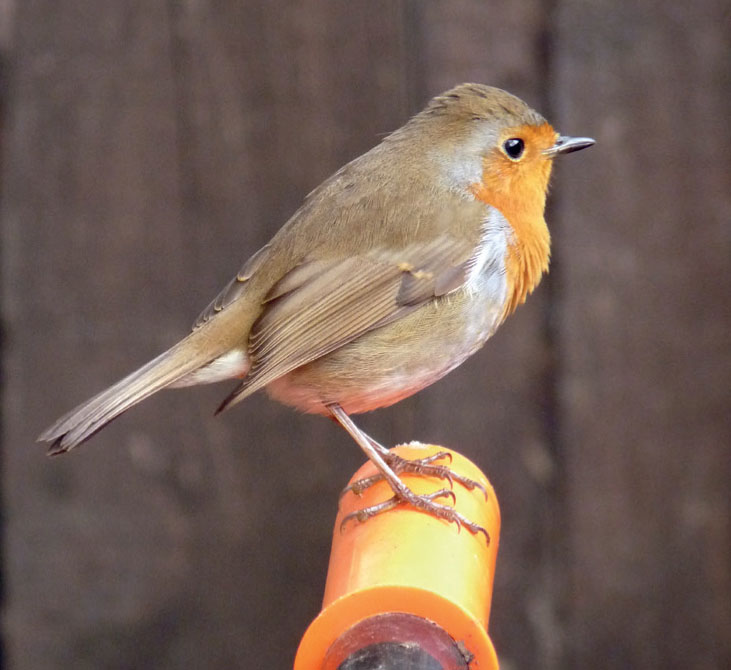
The Robin’s red breast is a powerful signal to rivals to back off, or prepare to fight.
Blue Tit
Cyanistes caeruleus
If they were rarer, we’d be bowled over by the beauty of these little acrobats. It’s probably the easiest bird to get to breed in your garden, and one of the most regular at bird feeders.
HOME NEEDS
Distribution: An abundant resident in lowland areas throughout the British Isles.
Habitat: Needs deciduous trees, especially oaks and birches, favouring sunny woodlands, parks, large gardens and hedgerows.
Habits: They work methodically from tree to tree, scouring branches and foliage for food, often dangling upside down. In winter, they wander in flocks with other tit species over an area of usually up to 10ha, although some are nomadic.
Food: Mainly insects and spiders gleaned from the trees, especially caterpillars in spring, but they also eat seeds, berries and nectar. Agile visitors to feeders, they take peanuts and sunflower seeds, and like to carry off large seeds to the safety of the trees – ‘tit takeaways’!
Roost: In a hole in winter; often in dense foliage in summer.
Breeding: Territory about 0.5–1ha. They nest in a tree hole, preferably 2–5m off the ground, and willingly use a nest box or hole in a wall. The nest is a thick wad of moss, fine grasses, wool and hair. They raise one brood (occasionally two). The 6–16 eggs in each clutch (fewer in small nest boxes) are laid in April–mid-May and are incubated for 12–16 days. The young fledge after 16–23 days.
So… Provide a nest box with a 25mm hole and keep those peanut and seed feeders topped up, but don’t stop there. If you want plenty of chicks to survive, you need trees full of insects. Go for leafy broadleaved trees, as large as you dare go.
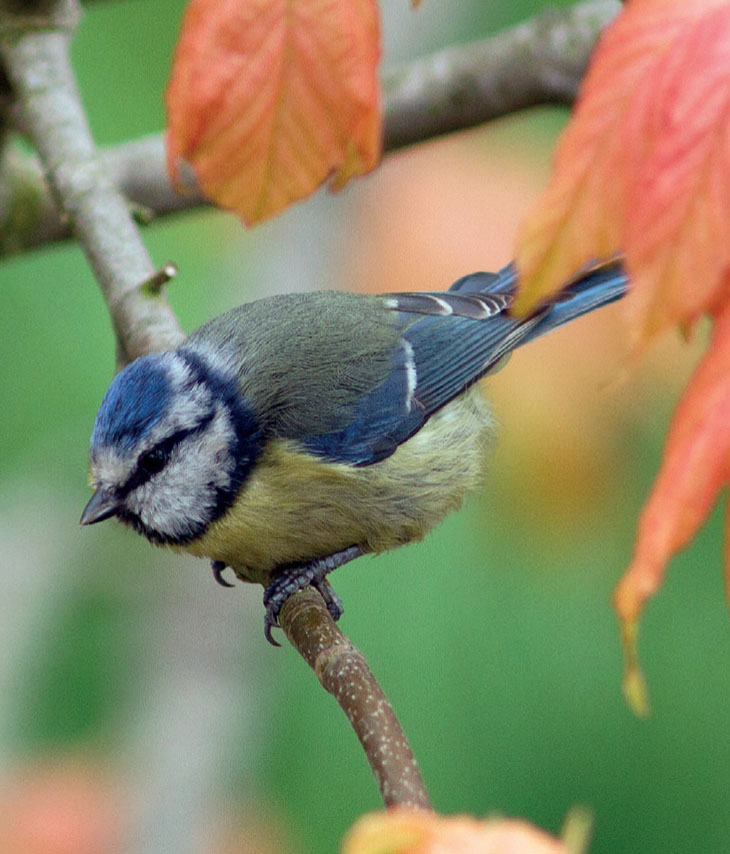
For a bird that is essentially a woodland species, the Blue Tit does incredibly well in gardens, but it does still need lots of trees.
Great Tit
Parus major
This bulky, strident tit with its cheery ‘teacher teacher’ song is not quite as common in gardens as its cousin the Blue, but is still a regular visitor to feeders and nest boxes.
HOME NEEDS
Distribution: A common resident throughout much of the British Isles.
Habitat: Likes deciduous trees and scrubby undergrowth, not too packed and with a few conifers, such as in woods, parks, gardens and hedgerows.
Habits: Forages through the trees, often low down in winter and even on the ground. Goes higher in spring to take caterpillars. Wanders about in small flocks in winter over an area of perhaps 4–8ha.
Food: Insects and spiders, especially moth caterpillars, beetles, flies and bugs. Also seeks berries and seeds in winter, including beechmast, hazelnuts and acorns. Takes peanuts and sunflower seeds at bird feeders.
Roost: In a hole (including nest box) in winter; in dense foliage in summer.
Breeding: A male defends a territory of 0.5–3ha. They nest in a tree hole, nest box or hole in a wall, making a nest similar to the Blue Tit’s only even more luxurious. They raise one to two broods. The 5–12 eggs in each clutch are laid April–May and are incubated for 12–15 days. The young fledge after 16–22 days.
So… The advice is the same as for Blue Tits, but the nest box holes should be 28mm diameter. To offer a garden stuffed with tree-living insects is the five-star hotel that will mean more Great Tits can raise more chicks.

The black line down the breast allows you to distinguish males (thick and solid line) from females (thin and patchy line, as here).
House Sparrow
Passer domesticus
From being the ‘common or garden’ bird, the House Sparrow’s calamitous decline was one of nature’s great mysteries. At last we know some of the things it needs to help it survive.
HOME NEEDS
Distribution: Common resident except in highland areas, but numbers are much reduced across almost all of the British Isles.
Habitat: Rarely seen far from habitation, they love allotments, stables and farmyards but are now found in far fewer gardens and are absent from many city centres.
Habits: In the breeding season, they live in small colonies of up to 20 pairs, but in winter may band up in flocks several hundred strong, often in stubble fields. They enjoy gossiping sessions (‘chapels’) in thick hedges and are fond of dust bathing. They always like to be close to cover but will readily perch on buildings.
Food: Seeds, taken mainly from the ground, especially cereals and grasses, plus some berries such as Elder. Insects such as caterpillars and aphids are crucial for the chicks. At bird tables, they enjoy sunflower hearts and peanut granules.
Roost: In autumn and winter, they gather in flocks in dense bushes; otherwise they roost in the nest.
Breeding: In the colony, nest entrances need to be at least 30cm apart. They prefer to nest in a hole in a building or nest box, preferably 3m up or more, but sometimes build free-standing domes in trees and climbers made of woven dry grasses. They fill nest holes with hay, too, and line the nest with hair, wool and feathers, and with aromatic leaves to ward off parasites. They raise two, three or even four broods. The three to five eggs in each clutch are laid April–August and are incubated for 11–14 days. The young fledge after 11–19 days.
So… Put up several nest boxes (with 32mm diameter holes) a couple of metres apart from each other, keep supplementary feeding year-round and provide nesting materials. But above all, fill the garden with insects: plant a hedge and deciduous shrubs, have a vegetable patch, don’t use chemicals... whatever it takes!
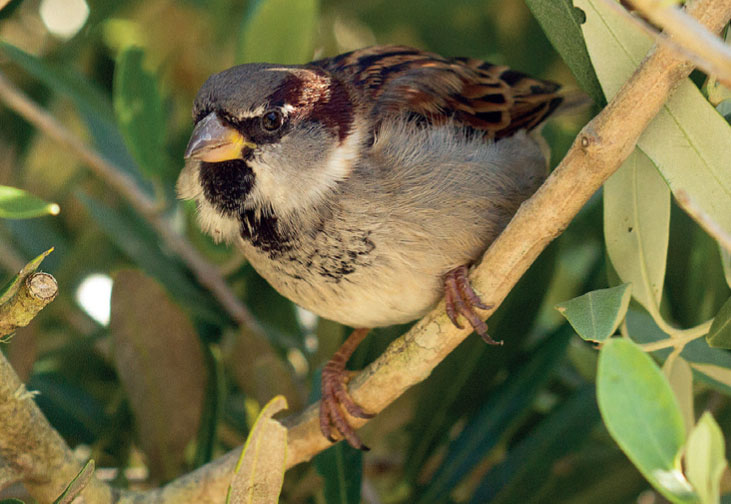
They may not be colourful, but there is something endearing about House Sparrows that perhaps we only appreciate now that their numbers are so depleted.
Starling
Sturnus vulgaris
Only now that its populations have plummeted do we fully appreciate the Starling’s full-on personality and star-studded plumage. This is a red-listed bird in need of help.
HOME NEEDS
Distribution: Abundant but declining resident throughout most of the British Isles, with numbers boosted in winter by birds from the Low Countries, the Baltic States and Scandinavia.
Habitat: Found in many habitats wherever there are nesting holes and grassland but especially on farmland and in gardens. Tends to avoid mountains.
Habits: Highly gregarious, hyperactive and curious, they often pick around livestock or flock with thrushes and Lapwings. They also like to bathe communally.
Food: In summer, they seek insects such as leatherjackets, beetles, flies and flying ants, plus worms. In autumn, they gorge on fruit and seeds such as elderberries and cereal grains. At bird tables, they take bread, sunflower hearts, fat, pastry, etc and can hang at feeders.
Roost: Famous for large winter ‘murmurations’, with astonishing synchronised flock manoeuvres, prior to roosting in reedbeds, conifers (including cypresses), on building ledges and seaside piers.
Breeding: They breed in a loose colony, each pair defending its nest. The colony feeds over an area of 10–80ha. They nest high up in a hole, mainly in buildings, but also in trees, cliffs, and in larger nest boxes with a 45mm entrance hole. Inside they make a robust cup of twigs and grasses lined with hair, wool and fresh leaves. They raise one to two broods. The three to six eggs in each clutch are laid April–May and are incubated for 11–15 days. The young fledge 21 days after hatching and are independent 10–12 days later.
So… On top of supplementary feeding, provide an insect-rich lawn, an Elder tree and a fruit tree, and why not put up Starling nest boxes?

Starlings find much of their food by probing in short grass, taking time out to preen and sing communally in trees and on overhead wires.
Chaffinch
Fringilla coelebs
A colourful and cheerful finch, usually top of the Big Garden Birdwatch charts in Scotland.
HOME NEEDS
Distribution: Abundant resident throughout almost all of the British Isles, with many more coming from Scandinavia in winter.
Habitat: In the breeding season, found wherever there are trees and bushes, but they really like a spread of big mature trees with lots of shrubs, and so do best in open woodlands and larger gardens. In winter, migrants will rove more widely on farmland.
Habits: A sometimes approachable bird, usually in small numbers in gardens, but larger flocks can build up in winter, especially on farmland.
Food: In winter, takes seeds of all sorts from the ground, including from cereals and grasses, the cabbage family and goosefoots. In summer, they are mainly insect eaters, taking aphids and caterpillars, and fly-catching in the trees. They are not very agile at feeders, preferring an open table or the ground, where they take sunflower seeds, rape seeds and linseed.
Roost: Alone, in a thick evergreen or thorn bush.
Breeding: The male defends a territory of 1ha or less but happily feeds outside it. The nest site is in a tree fork or out on a branch, most over 2m up and in a sunny spot. The neat, deep nest is a camouflaged cup of mosses and lichens, bound with spiders’ webs and lined with feathers and hair. They raise one, sometimes two broods. The four to six eggs in each clutch are laid late April–June and incubated for 10–16 days. The young fledge 11–18 days after hatching.
So… A typical large garden, with a mature tree or two, a shrubbery and well-stocked bird table, suits them very well. If that ‘mature tree or two’ can become three or four, and if you can grow an area of seed-rich flowers, all the better.
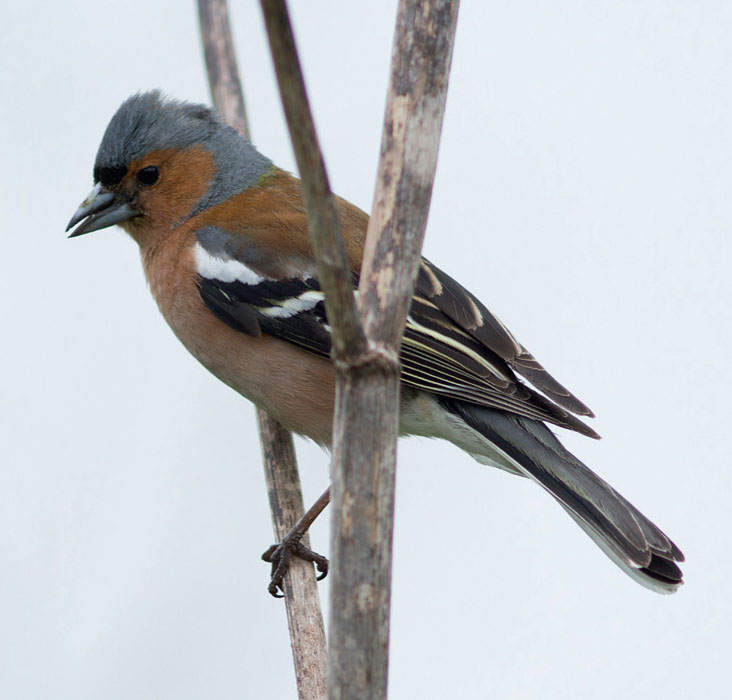
This is a natty male in his peachy breeding attire, but the white wing markings in the dark wing are the giveaway at all times of year for male and female Chaffinches.
Greenfinch
Carduelis chloris
Once a common sight at winter bird feeders, their numbers have been ravaged by the disease trichomoniasis (see here). Your hygiene regime at feeders is critical.
HOME NEEDS
Distribution: Found throughout most lowland areas of the British Isles, either as residents or moving short distances south and west for the winter.
Habitat: In the breeding season, they need a combination of trees and open ground rich in seeds, while in winter they sometimes move into farmland or coastal areas. Gardens suit them well.
Habits: In spring, males display in a weaving song flight above the trees, slowly beating their wings. Birds follow a daily routine visiting several feeding sites.
Food: Mainly large, hard seeds, taken from the ground, such as those of the cabbage family, cereals, docks and goosefoots. Will also eat berries including Yew, and rosehip seeds. Chicks are also fed insects, especially caterpillars, and spiders. At bird tables, they love sunflower seeds.
Roost: In winter, flocks gather at regular sites, often in dense evergreen shrubs or Ivy.
Breeding: Breeding pairs often nest in loose groups, with males defending just the area around the nest. They will travel quite a way to find food. The nest is built against a tree trunk or in the fork of a dense bush, small tree or creeper, deep in cover and often in conifers. It is a relatively large twig nest with grasses and mosses and lined with hair and feathers. They raise two broods. The four to six eggs in each clutch are laid May–July and are incubated for 11–15 days. The young fledge 14–18 days after hatching.
So… It’s especially important to keep feeders clean, and use hanging feeders where possible. Keep feeding into spring when Greenfinches struggle to find natural food. Provide roosting and nesting sites by planting a shrubbery or dense hedge of evergreens or thorns, and by growing Ivy up a wall or tree.

In winter, flocks of Greenfinches tend to sit high in trees. Then, when one bird drops down to food, the others are likely to soon follow.
Wren
Troglodytes troglodytes
What it lacks in size, this diminutive bird makes up for in volume. You can massively improve its fortunes in your garden by creating suitable nest sites and places to feed.
HOME NEEDS
Distribution: Abundant resident throughout the British Isles, only absent from uplands and open fields, but numbers are often low in gardens. Many die in cold winters.
Habitat: They prefer deciduous woodland with dense ground cover, especially along wet valleys, but are at home anywhere with tangled vegetation, rocks, log piles and thickets.
Habits: They behave rather like mice, exploring in, under and behind thick cover, rocks and logs, often near the ground.
Food: Small creepy-crawlies, especially beetles and spiders, but also bugs, small snails, flies, ants and woodlice.
Roost: Usually alone in vegetation such as Ivy, but groups may snuggle together in holes and nest boxes in cold weather.
Breeding: Males are territorial year-round, defending 0.5–2ha. Females wander blithely between males’ territories. The nest is made in a hollow against a tree trunk, in a tree fork, bramble pile or hole in a wall, often low down. It is a well-hidden domed chamber of grasses, leaves and moss lined with feathers and hair. The male makes up to a dozen and a female chooses her favourite! A male with a good territory may mate with two or more females. Each female raises two broods. The five to eight eggs in each clutch are laid April–July and incubated for 12–20 days. The young fledge 14–19 days after hatching.
So… You need to offer lots of possible nest sites and thousands of spiders and insects, so grow dense thickets, make several log and stick piles, plant hedges if possible, and cloak walls and fences with climbers, preferably over a trellis.

The shortest of wings and tail make nipping in and out of nooks and crannies all the easier for Wrens.
Dunnock
Prunella modularis
Dull in plumage, but not in character, this bird had an alpine origin but 200 years ago found a new home in gardens.
HOME NEEDS
Distribution: Resident and common throughout almost all of the British Isles, although scarce in the north and uplands.
Habitat: Anywhere there is dense, low cover in open habitats such as scrubby heaths, wasteland and hedgerows.
Habits: They spend much of their time on the ground, often deep in cover, hopping jerkily around and flicking their wings. They sunbathe regularly and get very excited when they meet each other. Males sing from prominent, though not high, perches.
Food: Spiders and insects such as ground beetles, weevils, earwigs, springtails, flies and caterpillars, plus worms and some weed seeds such as nettles, Yorkshire Fog grass and docks. May peck around underneath feeders and bird tables.
Roost: Alone or with a partner, 1–2m up in a dense thorny hedge.
Breeding: Each Dunnock maintains its own small territory (less than 0.5ha) overlapping with up to five others, with whom it has a complex mating system and hierarchy that would get tabloid tongues wagging. The nest is well hidden in a thick bush and is a cup of twigs, roots and leaves. They raise two to three broods. The four to six eggs in each clutch are laid March–August and are incubated for 12–13 days. The young fledge 11–12 days after hatching.
So… This is one bird where it is definitely your gardening rather than what you put on the bird table that will help. A good dense thorny shrubbery or a native hedge will work wonders and serve almost all their needs. I hate to say it, but a patch of Brambles and nettles would be good too.
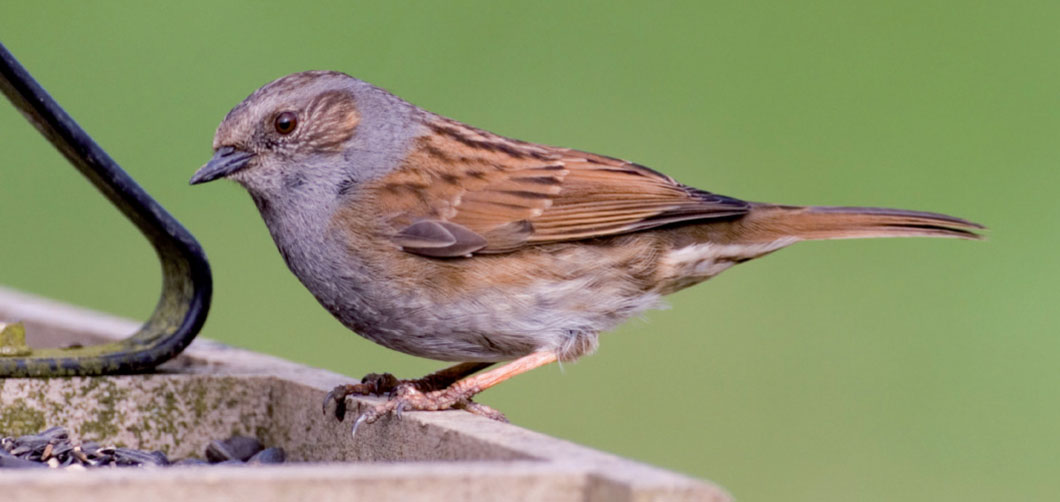
The fine bill, streaky cheek and grey neck separate the Dunnock from the very similar female House Sparrow, but watch how it nervously flicks its wings constantly too.
Collared Dove
Streptopelia decaocto
This delicate dove swept dramatically across Europe in the 20th century and is now a fixture in gardens almost everywhere, although numbers may be on the wane.
HOME NEEDS
Distribution: Common resident throughout most lowland areas of the British Isles.
Habitat: Needs a few trees or elevated perches, plus open ground for feeding, but otherwise it’s more the availability of grain or seed that makes the difference, hence their love of farmyards and gardens.
Habits: They gather in small groups to feed on the ground. In spring, males coo monotonously from telegraph posts and high trees, and have a wing-clapping rise-and-glide display flight. They are often quite tame and a benign presence at bird tables.
Food: Mainly cereal grains, and will eat sunflower hearts at bird tables. They also eat weed seeds and a few invertebrates.
Roost: Usually in groups in dense evergreens or thorn bushes.
Breeding: A few pairs often nest within the same general area and share the same feeding sites. The nest, made of just a few sticks, is usually 2m or more up in trees, hedges and bushes, close to the trunk. They raise up to six broods a year. The two eggs in each clutch are laid March–October and incubated for 14–18 days. The young fledge at 15–19 days and are independent a week later.
So… Grow a tall hedge for nesting and provide grain-based seed at bird tables, or on the ground if safe from cats. Job done!
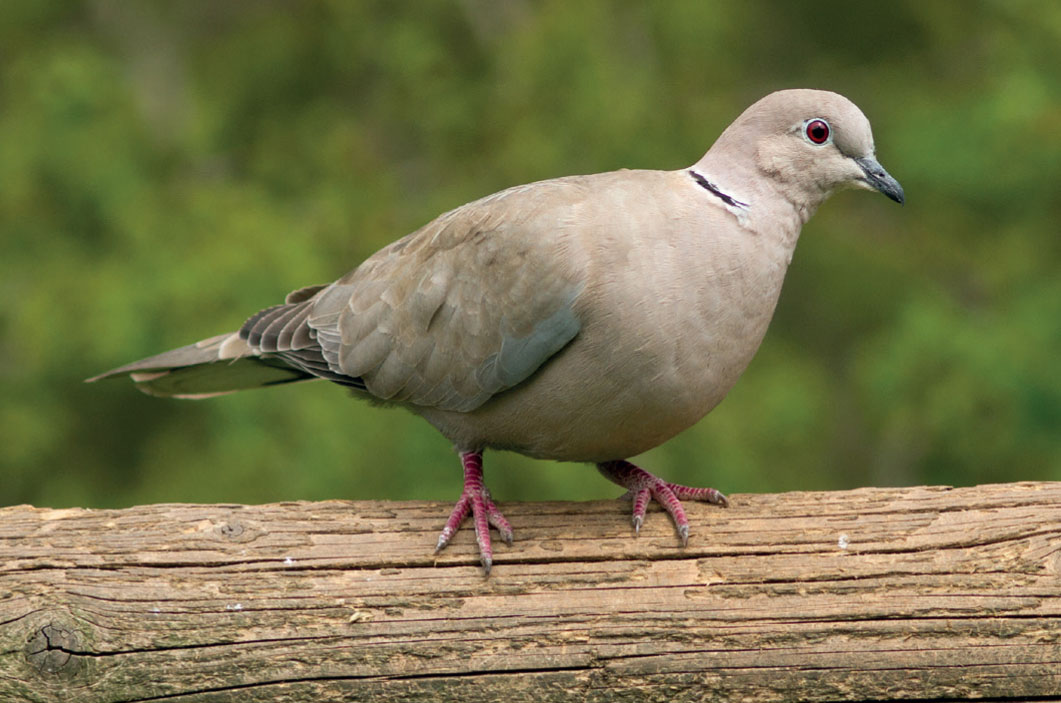
Collared Doves are prone to the disease trichomoniasis (see here), so keep bird tables clean.
Woodpigeon
Columba palumbus
This portly pigeon is proving to be an adaptable bird in gardens, with populations on the increase.
HOME NEEDS
Distribution: Abundant resident or partial migrant throughout almost all of the British Isles, although scarce in the mountains and north-west Scotland.
Habitat: Very adaptable, surviving in most places with trees, especially liking farmland with woods and spinneys, but increasingly doing well in gardens.
Habits: Gathers, often in flocks, to feed on open ground or sometimes on the woodland floor, retreating to the trees if disturbed. In the breeding season, the ‘lowing’ song is much repeated, and males display by flying steeply up, wing-clapping as they do, then stalling and gliding down.
Food: Mostly plant material, especially cereal seeds, Ivy berries, elderberries, and leaves of clovers, peas, beans and cabbages. At the bird table, they take sunflower hearts, grain, biscuits, cake… and lots of it if given the chance! They have quite a thirst too.
Roost: Tall trees with thick cover such as conifers or Ivy, using the same site each night.
Breeding: Males defend a small territory of a tree or two. The unsophisticated twig nest is built in the fork of horizontal branches in a tree or high bush. They raise one to two broods. The two eggs in each clutch are laid February–November and are incubated for 17 days. The young fledge three to five weeks after hatching.
So… Now that they have learnt to feel safe in gardens, Woodpigeons don’t need much more help. They can peck at peas, beans and cabbages in your vegetable patch, so be prepared to gently discourage them by carefully netting crops, and you can use scarecrows or dangle CDs that sparkle to startle them away.
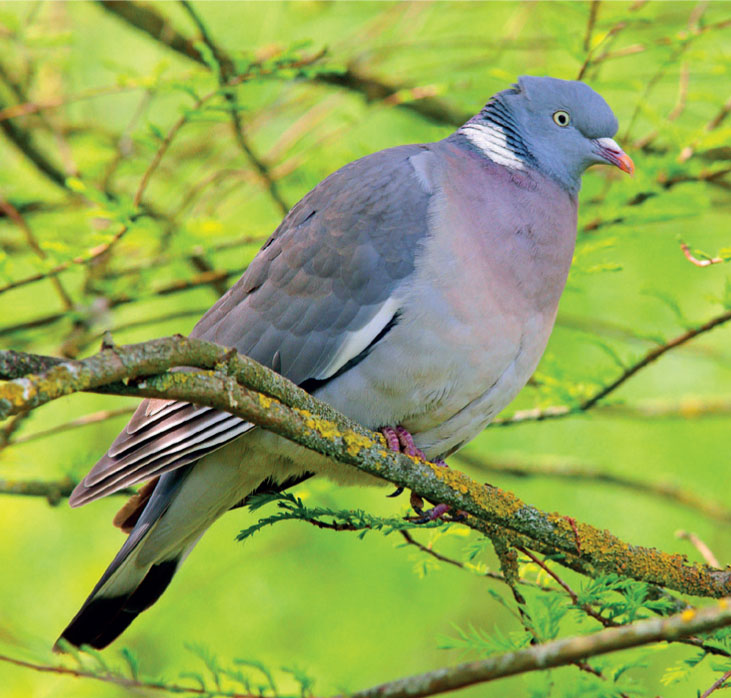
A real success story in gardens, Woodpigeons are now commonplace in the suburbs as well as rural areas. The white neck patch and plain closed wing tell it apart from the Feral Pigeon.
Mallard
Anas platyrhynchos
What a mixed relationship the Mallard has with us, sometimes ending up in the pot, at other times living cosily alongside us and taking full advantage of our handouts.
HOME NEEDS
Distribution: Resident across almost all of the British Isles, with more birds arriving in winter from eastern Europe and Scandinavia.
Habitat: They visit large, shallow waterbodies, whether flowing slowly or still, especially if there is plenty of bankside vegetation.
Habits: Often approachable, even tame, happily waddling about on land. They frequently gather in flocks. Males chase females in flight as part of courtship.
Food: Well, where to start? Grass, waterplants, seeds (especially cereal grains), insects (midges, mayflies, etc), worms, tadpoles, fish, even carrion, plus, of course, bread, rice and other human handouts. They pick food off the ground, from the water surface, or up-end while swimming, and will feed at night.
Roost: On the water’s edge, especially on islands, by day or night.
Breeding: A wide range of well-hidden nest sites are used, from dense cover such as bramble thickets, to more open rushy clumps, the tops of pollarded willows or inside hollow trees, and they will use nesting baskets. They sometimes nest in gardens that don’t have ponds – don’t worry, they usually know what they’re doing: leave well be. The nest is a grass cup stuffed with gorgeous thick down. They raise one brood. The 9–13 eggs are laid February–October and are incubated for 27–28 days. The young leave the nest when less than a day old, but do not fly until seven to eight weeks.
So… Supplementary duck food is available and is much more nutritious than sliced bread! But don’t overfeed – duck droppings can enrich the water in ponds.

Often seen on urban park pools, the Mallard is the only duck likely to visit garden ponds, and even then only large ones.
Pheasant
Phasianus colchicus
If you live near farmland, you may get wandering Pheasants under your feeders, especially if you feed grain to other birds. However, being a released gamebird, there is little need to encourage it.
HOME NEEDS
Distribution: Resident throughout most of the British Isles (except north-western Scotland). Populations are boosted by the huge numbers released each year for shooting.
Habitat: Woodland and woodland edge, and on farmland wherever they have access to thickets. They also need a good water source.
Habits: A social bird, with males establishing a clear pecking order. They spend most of their time on the ground, scratching and digging for food, and hate flying! They rarely move more than 1km from their birthplace. Males display from an open arena, loudly crowing and ‘drumming’ their wings.
Food: All sorts, but especially cereal grains and seeds, insects (beetles, flies and their larvae, etc) and worms, and plant food such as roots, shoots and berries. They are fond of acorns and blackberries.
Roost: Usually off the ground in trees or a thicket, and may spend much time sleeping.
Breeding: The male defends a territory of 0.5–5ha. The nest site is on the ground in thick vegetation, the nest being a barely lined depression. Females raise one brood. The 8–15 eggs are laid March–June and are incubated for 23–28 days. The chicks leave the nest on the first day and can fly short distances at only 12 days, but remain with their mother for 70–80 days.
So… If you live near farmland, you may get wandering Pheasants under your feeders, especially if you provide grain. A tray of water and a dense shrubbery for them to retreat into will also help.

Refugees from the farmland where they are released, garden Pheasants can sometimes lose their natural nervousness and caution.
Grey Heron
Ardea cinerea
A tall and mighty fishing machine, only likely to be seen in larger gardens with ponds.
HOME NEEDS
Distribution: Found across much of the British Isles. Populations crash in hard winters.
Habitat: They like all sorts of shallow water that isn’t too fast flowing, but they are surprisingly attached to trees and rarely found far from cover. They nest colonially, usually in big trees near water, so are an unlikely breeder in gardens.
Habits: Generally wary of people, they loathe coming near to buildings, but in London they are now much more tolerant and approachable.
Food: Half a kilogram of fish a day! They also take amphibians, Grass Snakes, dragonflies and small mammals. They feed alone, often at dusk and dawn but even at night, stalking or statuesque at the water’s edge, catching their prey with a lightning strike.
Roost: Will rest on the ground near feeding sites by day or night.
So… Herons rarely come into gardens, but a garden pond stuffed with goldfish or froggy snacks is clearly very tempting to a Grey Heron flying over.
Should you wish to safeguard ornamental fish in your pond, there are various means of deterring Grey Herons.
 Netting the pond is the most effective method, but is unsightly.
Netting the pond is the most effective method, but is unsightly.
 Scarecrows work well – with creativity, these can become a work of art.
Scarecrows work well – with creativity, these can become a work of art.
 Herons like to land near water and then walk up to it, so extend two wires or ribbons all around the margin, one 20cm off the ground, the other 35cm, as a visible deterrent, not a tripwire!
Herons like to land near water and then walk up to it, so extend two wires or ribbons all around the margin, one 20cm off the ground, the other 35cm, as a visible deterrent, not a tripwire!
 Placing a model heron at the pond edge is likely to draw others in, not scare them away.
Placing a model heron at the pond edge is likely to draw others in, not scare them away.

With their dagger-like bill, enviable patience, and lightning reflexes, Grey Herons are master fishers, for whom goldfish inevitably present an easy and colourful target.
Sparrowhawk
Accipiter nisus
A dashing bird of prey, this is the raptor most likely to be seen in gardens, even in cities.
HOME NEEDS
Distribution: Widespread resident throughout the British Isles (except north-western Scotland).
Habitat: Wooded countryside and farmland, but they cope well with urban environments.
Habits: They hunt in low dashing manoeuvres along regular flightpaths, often close to the ground, nipping over hedges and fences to surprise their prey. They will also ambush prey from a perch. Usually seen singly, they spend much of the day resting and loafing. They fly above roof height to check out potential hunting sites, and they will circle high in spring to display.
Food: Birds, with the smaller male taking sparrows, buntings, tits and finches, and the female preferring thrushes, Starlings and doves but even taking Woodpigeons.
Roost: Alone in a tree, changing sites regularly.
Breeding: They hunt over an area of 1,000–5,000 hectares but defend a much smaller area for nesting. The simple stick platform nests are hidden high in conifers or large thorn bushes. They raise one brood. The four to six eggs are laid May–June and are incubated for 39–42 days. The young fledge after 24–30 days and are independent 20–30 days later.
So… Some people enjoy seeing them in gardens; others find it distressing. You can make things a bit more challenging for them by regularly changing the location of bird feeders, but remember that the presence of a top predator is always the sign of a healthy food chain and environment.
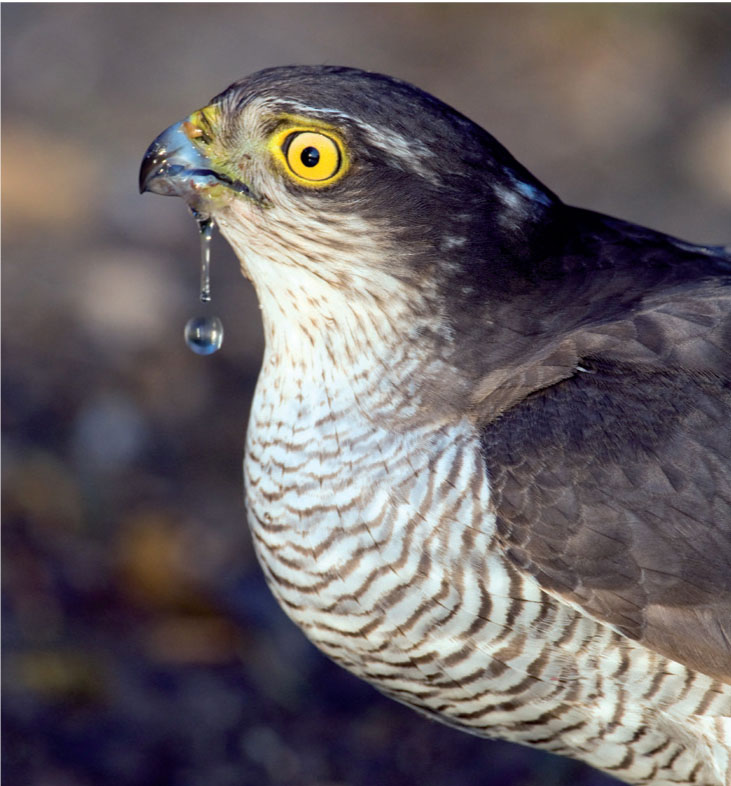
Sparrowhawks, with their orange eyes and barred underparts, can sometimes give fantastic close-up views in gardens – a mini-Tiger at work in our backyard jungles.
Kestrel
Falco tinnunculus
A rare garden visitor, this fabulous little falcon is famed for its precision-hovering over road verges, but its numbers are dwindling.
HOME NEEDS
Distribution: Resident or short-distance migrant across almost all of the British Isles.
Habitat: Open grasslands, such as downland and moorland, motorway verges and meadows. They also need safe perching places. A few pairs have adapted to city life.
Habits: Usually seen alone, they hover a few metres above the ground, sometimes beating their wings, sometimes just riding an updraught. They then plunge to the ground after prey. They sit for long periods upright on prominent perches such as tall buildings, telegraph posts, lamp-posts, bare trees and large rocks, and often choose to hunt in low light.
Food: Mainly voles, plus small mammals such as Wood Mice and a few beetles and other invertebrates. In urban areas, they will target small birds such as House Sparrows and Starlings.
Roost: In trees, on a cliff or on a building.
Breeding: Defends a small area around the nest, which is either an old Crow’s nest or a rudimentary cup of twigs and grasses on a building ledge, in a nook in a cliff or in a nest box. They raise a single brood. The three to six eggs are laid April–June and are incubated for 27–29 days. The young fledge after 27–32 days but are not independent for at least another month.
So… Not easy to help in the garden, and if you encourage Kestrels in urban areas they will probably feed on garden birds. But if you have the space in a rural garden, turn lawns into meadows so that voles can thrive and then wait for the ‘windhover’ to come.

While often confused with the Sparrowhawk, the Kestrel’s hovering behaviour and love of open spaces and elevated vantage points is as much a giveaway as any plumage feature.
Moorhen
Gallinula chloropus
The easiest waterbird to cater for, whose families will keep you soundly entertained if you can give them a big enough pond to play in.
HOME NEEDS
Distribution: In lowland areas throughout the UK, wherever there are suitable bodies of water.
Habitat: Sheltered lowland pools, lakes, streams, ditches and rivers, including urban parks. They like at least some open water, so a tiny garden pond isn’t enough. They also need abundant aquatic plants and thick cover at the pond margins.
Habits: They usually live in pairs or family groups, spending most of their time either sculling jerkily across the water looking for food or clambering through vegetation at the water’s edge. They sometimes potter about on land, never straying too far from the edge.
Food: A mix of plant material, mainly aquatic, such as duckweed, pondweed, rushes, leaves, seeds and fruit, plus some invertebrates such as molluscs, worms, spiders and tadpoles, and even carrion. They will peck at seed under bird tables.
Roost: In trees or in dense aquatic vegetation.
Breeding: A pair defends a linear territory along the water’s edge, in which they breed and feed. Their nests are cups of twigs and stems lined with grasses and reed leaves, and are made in amongst dense pond plants or on a floating platform, or occasionally in waterside trees. They raise two to three broods. The five to nine eggs in each clutch are laid April–June and are incubated for three weeks. The young fledge at six to seven weeks.
So… Even though Moorhens don’t need a huge lake, only a few of us have enough space for a large enough pond to fully satisfy them. However, you may live close to a ditch, canal or river, in which case a well-vegetated pond may become a nice addition to their territory, and they may even breed there.
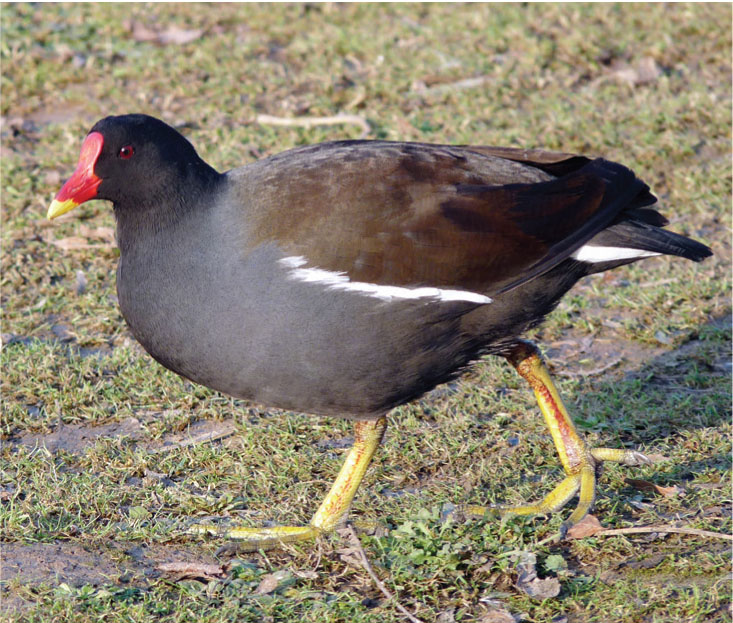
On city pools, Moorhens can become quite tame, but in rural areas they often remain shy and will scarper for cover – and even submerge – at the first sign of danger.
Black-headed Gull
Larus ridibundus
This relatively dainty gull (compared to the robust Herring Gull) is familiar from sports fields and the seaside, and is a winter drop-in visitor to a few gardens.
HOME NEEDS
Distribution: Breeds across the British Isles but in a relatively small number of often large colonies in protected wetlands. In winter, they are much more widespread.
Habitat: In summer they are found on saltmarshes, shallow lakes and gravel pits. In winter, they are more catholic, visiting coasts, estuaries, gravel pits, reservoirs, urban park lakes, rubbish tips, playing fields and arable farmland, but only a few gardens.
Habits: A gregarious gull, often gathering by day to preen and bathe. They only come into gardens to scavenge kitchen scraps.
Food: They take mainly worms and insects, following the plough avidly. They also snatch food from the water surface or by shallow plunge-diving. They will circle high to take flying ants in summer.
Roost: In large flocks at sea, on estuaries and reservoirs.
So… Encouraging them into gardens by providing food may attract larger gulls and is probably best avoided.

The Black-headed only retains a dark smudge behind its eye in winter, but the small build, red bill and red legs should give it away.
Herring Gull
Larus argentatus
The archetypal seagull, included in any child’s drawing of the seaside, but now unfortunately sometimes coming into conflict with people as its breeding habits change.
HOME NEEDS
Distribution: In the breeding season they are found around much of our coast, although increasingly in cities; they travel widely inland in winter.
Habitat: They once bred predominantly on seacliffs but have undergone massive declines there. The rapid rise in rooftop populations, mainly in coastal towns, has not offset these losses. In winter, they are regular on beaches, rubbish tips, estuaries, sports fields and farmland.
Habits: A large, rather imposing and very gregarious gull, often loud and sometimes quite fearless of people. They make long feeding flights of up to 50km to find food. Problems can arise when pairs are nesting, including noise, fouling and ripping open rubbish bags. Also, if you stray near their eggs or chicks they see it as a threat and can dive-bomb to try to frighten us away. They generally avoid actual contact, but if people cower rather than fending them off, they can be bold enough to have a peck.
Food: Almost everything! They eat dead fish, shellfish and crabs on the tideline and at sea, but they are very adaptable and follow the plough for worms, scavenge fish offal in ports and grab human rubbish in the street, on beaches, in gardens and at dumps. They often harry and rob other gulls. But they don’t eat bird seed or cling to feeders.
Roost: Outside the breeding season, many travel each evening to spend the night on reservoirs or the sea.
Breeding: They form large loose colonies on cliffs or rooftops. They especially like flat roofs, or will wedge their nest, made of grass, moss and seaweed, behind or between chimneys. They lay one brood of two to four eggs April–June, incubated for 28–30 days. The young fledge after 35–40 days.
So… Nationally, this is a declining bird that most certainly shouldn’t be vilified. However, when gulls come into conflict with people, neither side wins. Do not feed them and use peck-proof bin-bags or put rubbish out in a closed bin. Restrict yourself to feeding bird seed in feeders for smaller birds.
If gulls are a problem on your property or you want to deter them from nesting, the only sustainable solution is to block potential nest sites. Use netting or anti-bird spikes, but do it in winter and not when the birds are actually nesting; remember breeding birds are protected by law.

The Herring Gull has a bill capable of ripping into unguarded bin bags, and has taken readily to nesting on roofs, which mimic its original cliff top home.
Feral Pigeon
Columba livia
Its ancestors may have been wild Rock Doves living on cliffs, but our high-street pigeons are escaped or lost domestic pigeons and their descendants.
HOME NEEDS
Distribution: Common and sedentary resident throughout most urban and coastal areas.
Habitat: They need tall buildings or cliffs to perch and nest on, plus a source of fresh water. They especially like abandoned buildings, railway stations, under bridges and big public buildings.
Habits: They loaf in flocks on roofs, wheeling down to the ground to feed. In parks and city squares they can become incredibly tame, strutting and cooing around our feet.
Food: They probably eat more human food than natural, enjoying everything from bread and chips to cheese, and feeding all night in well-lit areas. At bird tables they take most scraps and birdseed.
Roost: Under cover high on buildings.
Breeding: Can breed when less than a year old. They nest in loose colonies on ledges and in nooks and crannies, usually preferring elevated sites and building a rough cup of stems and roots. They raise five or more broods a year. The two eggs in each clutch are laid mainly February–November (but have been recorded in every month) and are incubated for 16–19 days. The young fledge at 25–35 days and are attended by their parents for up to another ten days.
So… Some people in urban areas, who see little other wildlife, are fond of pigeons; those who have to deal with their fouling of buildings, pavements and public places are not so keen. In gardens, they can provoke disputes between neighbours, so it is usually best not to encourage them. If so, use bird feeders that exclude pigeons and keep them out of potential nesting areas with netting as long as you are sure they are not nesting at the time.

Any Feral Pigeon without a metal ring on its leg is likely to have been raised in the wild; those with rings are ones lost by their owner.
Rose-ringed Parakeet
Psittacula krameri
This noisy, in-your-face, bright-green parrot looks set to stay – and spread. Urban myths surround its introduction – were they off the set of The African Queen, or escapees from Jimi Hendrix parties? Whatever the reason, numbers are booming.
HOME NEEDS
Distribution: This introduced species is found mainly in the London area, but is expanding into north Kent, Berkshire and Surrey. Another small population is well-established in south-east Kent.
Habitat: Although originally a tropical species, they are doing fine in urban and suburban gardens and parks, but need tall trees with nesting holes.
Habits: They travel widely during the day to look for food, often in groups, and rarely descending from the trees. Often very noisy, their squawk can be piercing.
Food: Largely fruits (apples, pears, grapes, etc), berries, cereal grains, seeds and nuts, but also flower buds and nectar. They readily take peanuts and seed mixes at bird tables.
Roost: In winter, they make long journeys daily to communal tree roosts where several thousand birds can gather. In the breeding season, they roost in or near their nest.
Breeding: Loosely colonial, a pair just defends their nest hole, which is either an old woodpecker hole or a natural one lined with just a few wood shavings. There is a single brood. The three to four eggs are laid January–June and incubated for 22–24 days, the young fledging at 40–50 days.
So… Be aware of the potential problems – as well as their noise and boisterous behaviour at bird feeders, they can strip fruit trees, and there are concerns that they may oust native hole-nesting species such as Starlings. Use feeder guards if you want to keep them from food.

Parakeets are relatively dominant birds at the bird table, with a powerful hooked bill to boot.
Barn Owl
Tyto alba
Usually seen as a pale ghost in the half-light or headlights as it floats along verges and hedgerows, it’s hard to find a bird with more charisma.
HOME NEEDS
Distribution: Resident if very scarce throughout most lowland areas of the British Isles, although a rarity in Scotland.
Habitat: Mainly farmland with scattered hedges, trees and small woods, especially where there are ample rough verges, margins and unimproved pasture. Often found on the edges of villages but not in urban areas. In gardens, rare in all but the largest.
Habits: They head out at dusk to hunt alone, slowly quartering grassy areas a couple of metres above the ground, hovering if something catches their eye (or ear). They sometimes pause for a while on the ground or a fence post. The screech call of the male is chilling.
Food: Small mammals, especially voles and mice, plus a few birds and amphibians.
Roost: By day in an undisturbed dark hideaway in barns and ruins, occasionally in bushes.
Breeding: A pair maintains a territory throughout the year of 40–250ha. They nest in a dark hole, often in a barn or ready-made nest box, sometimes in a cliff or quarry, but they need a big, flat floorspace. No nest is created within the hole. There is one brood, exceptionally two. The four to seven eggs in each clutch are laid April–August and are incubated for 30–31 days. The young fledge at 50–55 days and are independent a month later.
So… If you have a small garden, there’s unfortunately little you can do. If you have a large rural garden, create a meadow; it will only provide a small part of their huge hunting territories but that could be critical. Barn Owl nest sites are often in short supply, so if you have the chance, erect a box either in an outbuilding or on a pole in an undisturbed part of the garden, facing east, north-east or south-east.

Occasionally seen as a ghost in the headlights, the Barn Owl is almost white underneath, and has a fearsome screaming call. Populations are still perilously low, so help them if you can.
Tawny Owl
Strix aluco
Rarely seen but often heard, this is the hooting owl that kids like to mimic. It’s a surprisingly frequent visitor to gardens with large trees, even in urban areas.
HOME NEEDS
Distribution: Resident across much of Britain, even to some altitude, but absent from Ireland.
Habitat: They need mature trees in woods, copses, churchyards, parks and large gardens.
Habits: They hunt almost exclusively at night, either in flight or from an elevated perch. Their short wings allow them to twist and turn, and they will plunge into bushes to catch roosting birds. Males mainly call in late autumn and spring. Can be highly aggressive at the nest.
Food: Small mammals and small birds such as sparrows, Starlings, thrushes and doves. Also amphibians, young Moles, plus some beetles, worms and even fish.
Roost: By day on a high branch, often up against the trunk; sometimes in holes. A pair will roost together in winter.
Breeding: A pair holds a territory all year, which can be as small as 5ha but usually 10–100ha. Many don’t breed every year. When they do it is usually in a tree hole, or occasionally in a special nest box. There is a single brood, the two to four eggs being laid March–May and incubated for 28–30 days. The young fledge at 25–30 days, clambering from the nest when still down-covered, and are independent a month later.
So… If you increase the number of smaller birds and mammals in your garden, Tawny Owls will benefit, although be cautious about encouraging them to breed due to their aggressive nature.
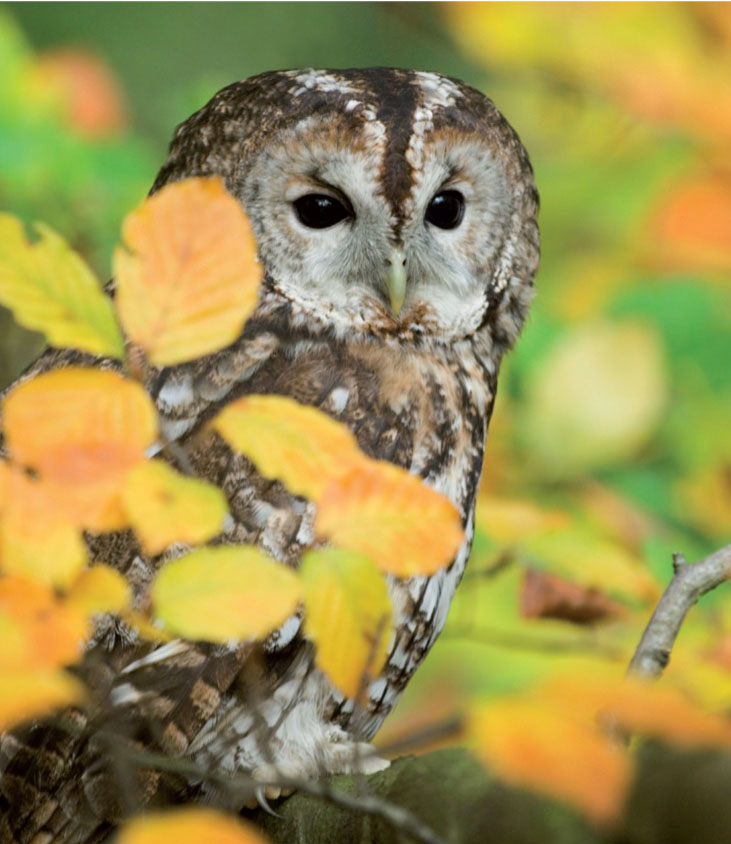
A master of camouflage in its daytime tree roost, many a time you will have been watched by a Tawny Owl without you knowing a thing about it.
Swift
Apus apus
If you live several storeys up, you are particularly well-placed to help these aerial masters and address their chronic shortage of nest sites and population decline. You may be rewarded by their exuberant screaming chases over the rooftops.
HOME NEEDS
Distribution: In summer, found across most of the British Isles.
Habitat: Uninterrupted airspace with insects. They come to land only to nest on cliffs and the human equivalent, tall buildings.
Habits: They arrive back from Africa in May and leave by early August, and have a lot to pack in to their three months here. They fly in loose flocks at a great height and for huge distances, chasing the best weather, and courting, mating and sleeping on the wing. When visiting their nest, which must have a clear flight line to it, they take several approaches to make a successful landing. Once inside, they can only shuffle about on their tiny legs.
Food: Flying insects and wind-borne spiders, but they avoid bees and wasps. Adults collect a ball of insect pulp in their throat to bring back to the young.
Roost: High in the sky most of the year, but in the nest through the breeding season.
Breeding: They nest colonially, up to a few dozen pairs in the local area. They mainly use flat internal roof spaces in old buildings or special Swift nest boxes, returning to the same site each year and making a modest nest cup of feathers and saliva. They raise a single brood. The one to four eggs are laid in June and incubated for 18–24 days, the young fledging after 37–56 days.
So… If you have a house wall where a Swift box can be placed, preferably under the eaves on the second storey or higher, it is sorely needed (see here). Maybe there is somewhere suitable at your workplace too. Playing tapes of Swift calls in May to attract them increases your chances of success.
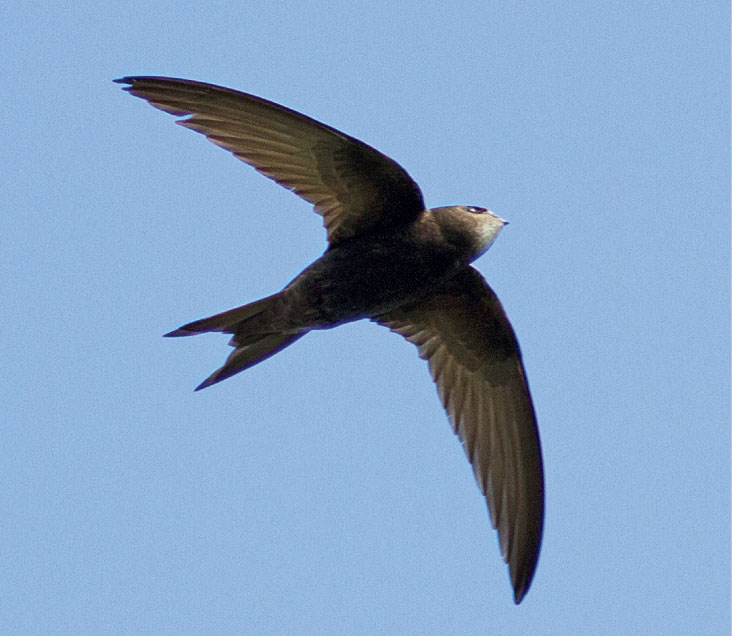
Let the RSPB know where you see Swifts flying low over houses in summer – we would like know to build up a better picture of where they are surviving.
Green Woodpecker
Picus viridis
It’s a thrill if this charismatic joker, moss-green with a bold red cap and highwayman’s mask, comes hopping about your lawn.
HOME NEEDS
Distribution: Localised resident throughout the British lowlands; absent from the far north of Scotland and from Ireland.
Habitat: Open deciduous woodland, parkland and orchards, with unimproved grassy areas.
Habits: They seek ants in warm grassy banks and in trees, and can be rather nervous, fleeing with a characteristic bounding flight and ‘yaffling’ call.
Food: Ants and their grubs are vital, licked up using their very long, sticky and sharp-tipped tongues. They will take other insects where available, including from behind bark.
Roost: In a tree hole.
Breeding: A pair defends a territory of 30–100ha. The nest is an unlined hole in a tree 30–50cm deep, the entrance 6cm wide; they either excavate their own or reuse an existing site. Each pair raises a single brood, the five to seven eggs being laid April–July and incubated for 17–19 days. The young fledge after three to four weeks.
So… You’ll be hard pushed to encourage them into small or urban gardens, but if you live in the country or near suitable habitat, keep those lawns chemical free, boost your ant population and retain dead standing trees where possible. It is also worth trying a large nest box – although they may modify the box a bit for you!
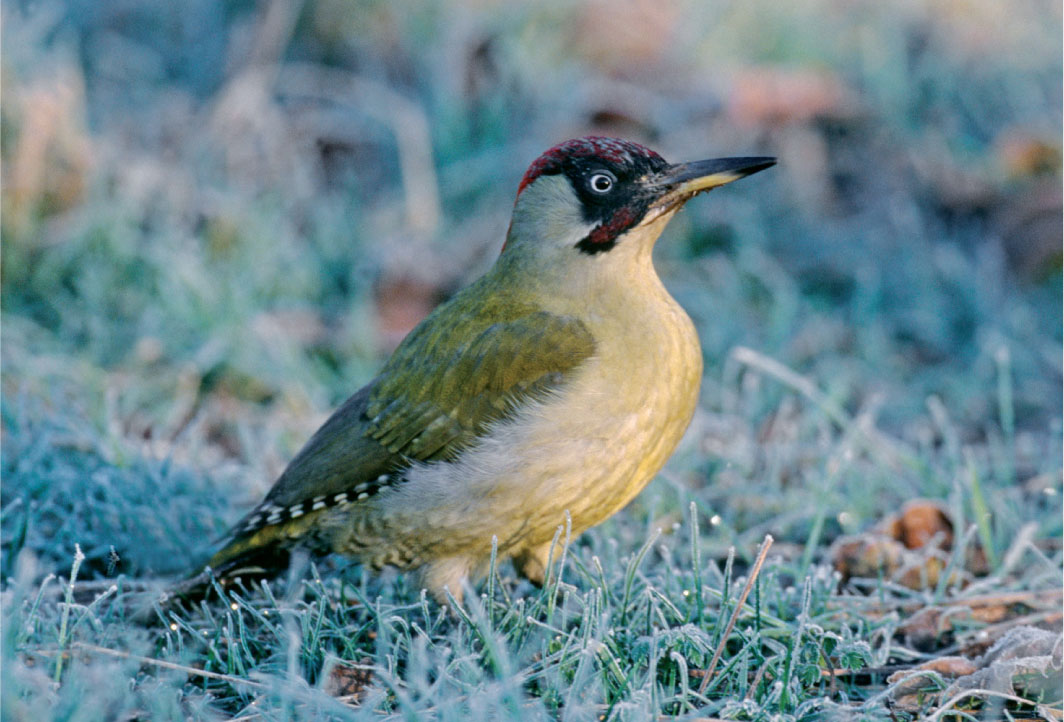
A woodpecker on a lawn may seem incongruous, but this is prime habitat for the Green Woodpecker, an ant-licking specialist.
Great Spotted Woodpecker
Dendrocopos major
The commonest woodpecker in gardens, but each visit is still exciting. It’s quite easy to draw them onto your feeders, but your challenge is to fulfil even more of their needs.
HOME NEEDS
Distribution: Resident or short-distance migrant throughout Britain, but rare wherever trees are scarce. Very rare in Ireland.
Habitat: They like plenty of good-sized trees, especially a mix of deciduous and conifers.
Habits: They spend most of their time shimmying up branches and hammering out insects from the bark. They can cling well to bird feeders, but are often wary. Males drum in spring to attract a mate, often on resonant wood but sometimes on a telegraph post.
Food: Insects found in trees throughout the year. In autumn and winter, they take seeds from pine, spruce and Larch cones, and the fruit/nuts of Hazel, Hornbean, Beech and oak trees. At bird feeders they like peanuts, sunflower hearts and fat. They will take some bird eggs and nestlings in spring.
Roost: In an old hole or large nest box.
Breeding: The breeding territory is small, but they feed over a wider area. They hammer out a nest hole 3–5m off the ground in a dead or dying tree, often using the same one year after year. The entrance is 5–6cm wide and the chamber 30cm deep. They raise one brood. The four to seven eggs are laid April–July and are incubated for 10–13 days, with the young fledging 20–24 days after hatching.
So… Bird feeders are the easiest way to try to get regular visits. In addition, leave dead standing timber wherever possible (a real rarity in gardens) and, for the long term, plant suitable tree species, especially birches.

A Starling-sized black-and-white woodpecker with a big blob of white on the wing is the Great Spotted. The sparrow-sized Lesser Spotted is now very rare.
Swallow
Hirundo rustica
A bird that country folk will know well and city dwellers almost never see – if you are visited by these harbingers of spring, treasure them.
HOME NEEDS
Distribution: Summer visitor from sub-Saharan Africa (and even South Africa) to most of the British Isles.
Habitat: Mainly farmland, often near water, and avoiding woods, uplands and urban areas.
Habits: They arrive here in April and May, and fly low and fast over grassy fields, especially around cattle and horses or over water. They only land on the ground to collect nesting materials. They are gregarious outside the breeding season, mixing with martins and gathering on wires. On migration, thousands pass along the coast, departing south in September and October.
Food: Flying insects, especially flies, plus flying ants, aphids and others.
Roost: In the breeding season, they roost in the nest or nearby. On migration, they drop into reedbeds, tall grasses and maize fields to spend the night.
Breeding: They often nest in small colonies, just a handful of pairs, with many returning to the same site each year. The nest is almost always in an open building such as a barn, stable, outbuilding or porch on a beam, ledge or shelf, and is a half-cup of mud and straw, lined with feathers. They raise two to three broods. The four to five eggs in each clutch are laid May–August and are incubated for 11–19 days. The young fledge 18–23 days after hatching.
So… If you live near open pasture, offer them a suitable nest site by leaving a barn window or outhouse door open. You will hopefully be rewarded with loyal repeat guests.
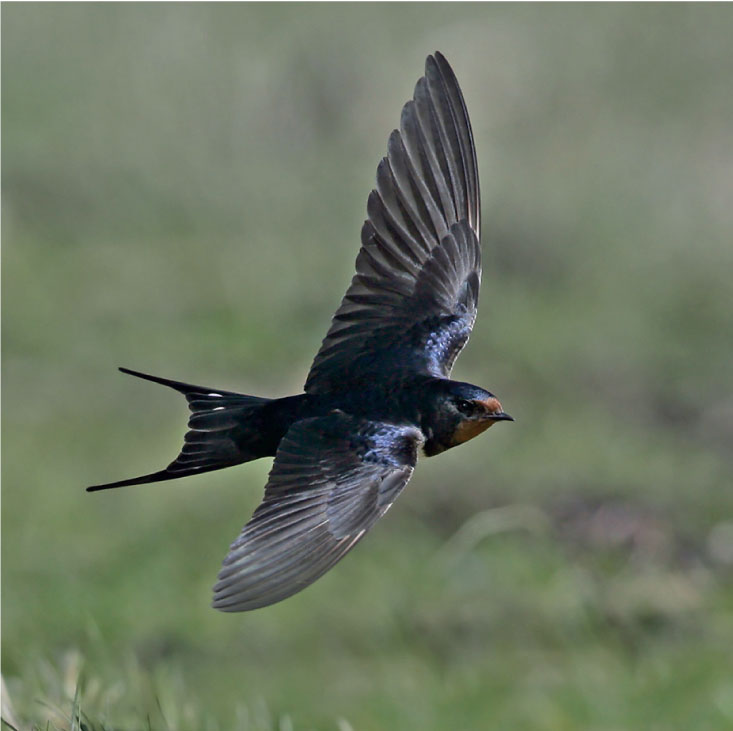
Swallows have a red face and deep blue throat band, unlike the House Martin which has a plain white underside and white rump.
House Martin
Delichon urbica
To have House Martins nesting under the eaves was one of my childhood joys – their gentle night-time chatter just outside the window is a comforting sound of summer.
HOME NEEDS
Distribution: In summer, found throughout most of the British Isles, although numbers have fallen considerably. They migrate to Africa for the winter, although exactly where they go is poorly known.
Habitat: Birds of the air, they zip about high in the sky and only come down to earth to breed, collect nesting materials and drink. They are most frequent over habitation and areas of water.
Habits: They arrive in April and May, and spend much time flying around in loose flocks catching insects, only coming low if chilly weather forces insects down. Mud for their nests is collected from the ground. In autumn, large numbers pass along the coast and gather on wires, with most having left by early October.
Food: High-flying insects, especially flies and aphids but also beetles and flying ants, brought to their young in sticky blobs – lucky them!
Roost: Usually in the nest, arriving after dark, but some may sleep on the wing. On migration they will roost in the nests of other House Martins.
Breeding: They nest in colonies, most fewer than five pairs but some of several hundred. They build a virtuoso nest of 1,000 pellets of mud, lined with a few feathers, usually on buildings or bridges and at least 3m up on a vertical wall under the eaves. Pairs will reuse and repair the previous year’s nest. They raise one to three broods. The three to five eggs in each clutch are laid May–August and incubated for 14–16 days. The young fledge 22–32 days after hatching.
So… If you have a high wall with eaves, put up an artificial nest. If one pair finds it, others will probably build alongside. Be prepared to wipe up droppings from the window sills beneath the nests, but it is a small price to pay for their company. Why not create a mud puddle for them on open ground too?

House Martins need to be able to swoop up to their nest at speed and without hindrance – few will nest under the eaves of a bungalow, or where there are trees nearby.
Pied Wagtail
Motacilla alba
Rather energetic and restless, this is more a bird of driveways and roadside gutters than back gardens, but there’s the chance you may be able to help it nest.
HOME NEEDS
Distribution: Resident throughout most of the British Isles, but they are only a summer visitor to higher ground and northern Scotland.
Habitat: Likes open places, often by still or slow-moving water such as lakes and canals. Also regular wherever the ground is bare or freshly turned, where vegetation is very short, or where flies are abundant, such as closely grazed pasture, ploughed earth, playing fields, seashores, sewage farms and farmyards. Around gardens, they visit large lawns, roads, roofs, car parks and paved areas.
Habits: They walk and run across the ground, chasing small insects or picking them from the surface, their tail wagging relentlessly. They rarely perch in trees by day and are often quite tame.
Food: Mainly flies such as midges and craneflies, plus some beetles and aquatic insect larvae. They take a few seeds, especially in winter, so will scavenge under bird tables for fragments.
Roost: In the breeding season, they roost alone in their territory. In winter, they gather in large flocks in reedbeds, high-street trees and supermarket roofs, travelling many kilometres each evening to join the throng.
Breeding: A pair defends a territory of at least 3ha. They nest in holes or crevices, often in stone buildings or walls, frequently close to ground level. Their nests are cups of twigs and grasses, lined with soft feathers and wool. They raise one to three broods. The four to six eggs in each clutch are laid April–July and are incubated for 11–16 days. The young fledge 11–16 days after hatching.
So… A mown lawn and sunny bare-edged pond may prompt them to visit, but they will still probably prefer to spend time on your drive! If you are fortunate enough for them to be regular, you might try an open-fronted nest box to entice a pair to breed.
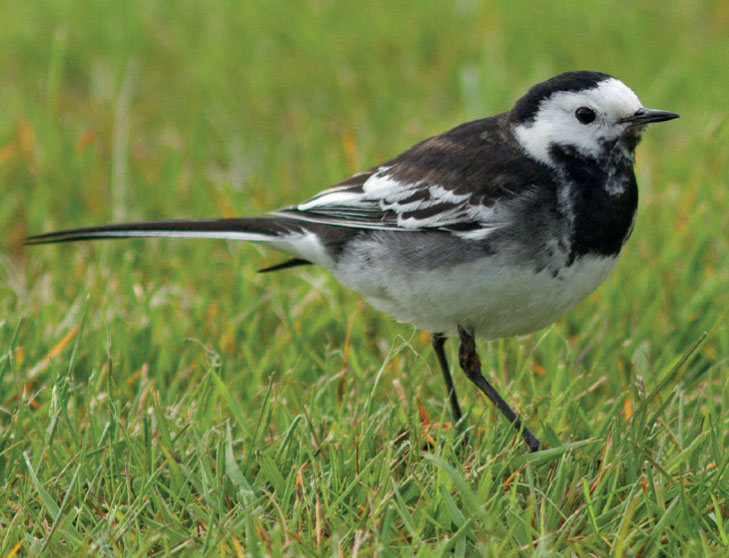
The fine bill of the Pied Wagtail gives away the insect-eating lifestyle, and the horizontal carriage is the mark of a runner, not a tree climber.
Grey Wagtail
Motacilla cinerea
Even longer and waggier-tailed than the Pied Wagtail, this denizen of fast water can sometimes stray into gardens in winter.
HOME NEEDS
Distribution: Found sparsely throughout much of the British Isles where they are residents or short-distance migrants.
Habitat: In the breeding season they are tied to fast-flowing streams where the water churns over rocks and weirs, especially those in wooded valleys with gravel bottoms and boulder-strewn margins. Some move into more lowland and even urban areas in winter but still near water.
Habits: As with the Pied, they hop, skip and jump along the water’s edge. They can hover, and for a bird with such a long tail, they make surprisingly agile flying sorties after insects.
Food: All sorts of insects from damselflies to mayflies to midges, plus caddis flies and their larvae.
Roost: In winter they gather in small flocks, often in reedbeds.
Breeding: Few breed in gardens. Territories follow the course of a river, with most nests made in traditional sites next to water in bankside holes, cracks and crevices.
So… If you are fortunate to live alongside a stream, you may be visited regularly. For the rest of us, try a large garden pond with open stony margins and a bubbling water feature.
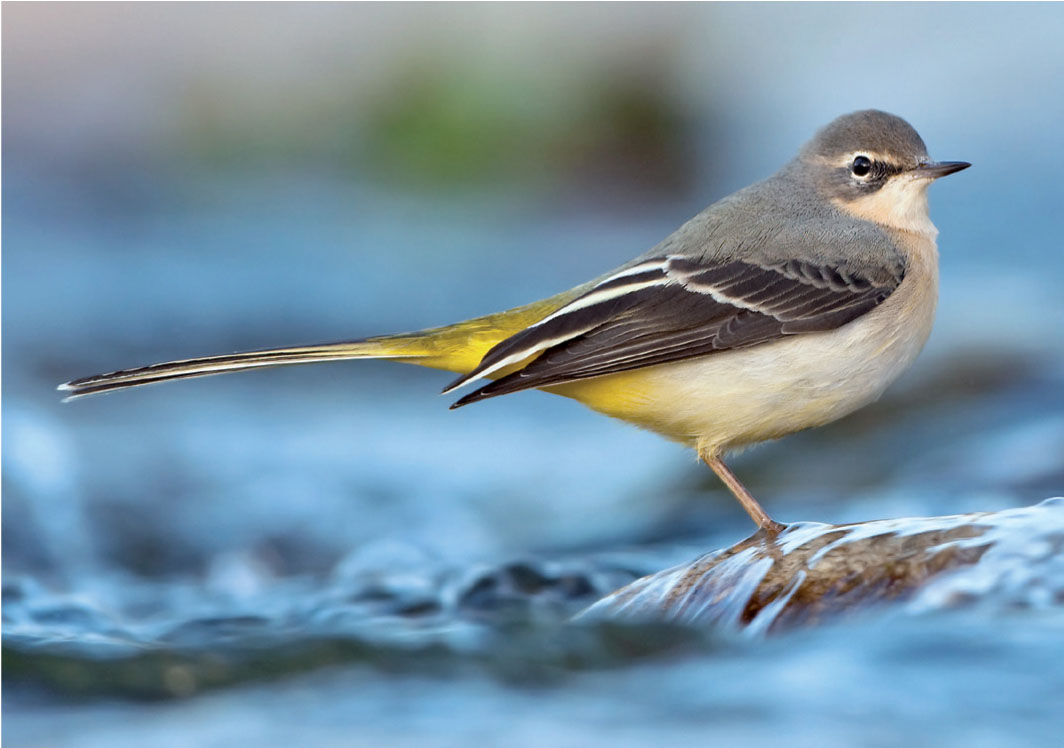
In winter, when most Grey Wagtails are seen in gardens, they have lost their bright yellow underparts and black chin, but the yellow under the extra-long tail should give them away.
Waxwing
Bombycilla garrulus
What a bird! So elegant, so unpredictable – everyone wants a visit from a flock of these elusive northern wanderers.
HOME NEEDS
Distribution: They breed no closer than northern Scandinavia, but each winter they push south and west, reaching Britain annually, especially eastern counties. Numbers vary from almost none in some years to thousands in others.
Habitat: In winter, most likely to be seen in urban environments, from housing estates to supermarket car parks.
Habits: They are very gregarious in winter, their strange, high, bell-like call drawing in other Waxwings as they rove nomadically, almost desperately, in search of food. They often perch high in trees, and then zoom off to converge on berry-laden trees and bushes.
Food: They are berry and soft-fruit specialists, gorging on twice their body weight a day, with most food taken from a tree rather than the ground. Rowan berries are a favourite, but by the time they arrive in the UK few are left for them. Hawthorn berries (haws), crab apples, rosehips and almost any other berry are all taken avidly.
Roost: In trees.
So… There are so many other advantages of growing berry-bearing trees that you might as well go for it and plant as many as your garden will allow in the hope that one day you will be lucky.

What a bird! With its wild crest, apricot-coloured suit and heavy eyeliner, if you attract a winter troupe of Waxwings you will be the envy of your neighbourhood.
Black Redstart
Phoenicurus ochruros
A perky little fella, like a soot-coloured Robin, this UK rarity has a curious penchant for rooftops and industrial landscapes.
HOME NEEDS
Distribution: A scarce migrant and winter visitor to English east and south coasts, with a few breeding in south-eastern England and the Midlands.
Habitat: They like rather dry, barren, stony places, avoiding trees, wetlands and lush vegetation, and have adapted well to rooftops. In winter in England, they visit undercliffs, coastal harbours and warehouses, while in summer they are found around factories, power stations and urban ‘green’ roofs. They made use of bombsites after the Second World War.
Habits: They hop and run over rocks and roof tiles, dashing to grab insects, quivering their rufous-tinged tail. One bird often remains faithful to a small feeding area. Males sing from elevated vantage points such as gable ends.
Food: Insects, such as beetles, ants, bugs and grasshoppers, plus spiders. They also take some berries and a few seeds.
Roost: Hole in a cliff or building.
Breeding: The territory can be as small as 0.5ha but up to about 5ha. The nest is built in a hole in a building, rock face or nest box. It is a cup of moss, leaves and plant stems, lined with softer material. They usually raise two broods. The five eggs in each clutch are laid May–June and incubated for 13–17 days. The young fledge 12–19 days after hatching but a family may stick together for several more weeks.
So… This is one species you are more likely to see on a summer European holiday, whereas in England you are very lucky if they visit your garden. However, if you live or work in an urban location in an area known for them and you have the chance to influence the development of ‘green’ roofs, they are the best way of helping this unusual bird.
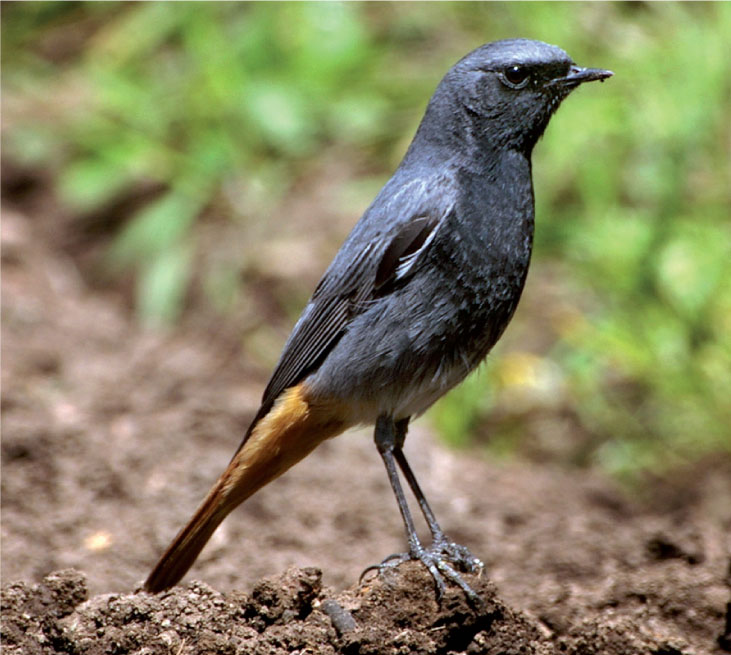
A bit of a continental speciality, a few urban or coastal rooftops in Britain play host to this sooty little bird with a russet tail that it likes to shimmy repeatedly.
Fieldfare
Turdus pilaris
Bold and noisy, this attractive thrush with its exuberant ‘chack chack’ call is one of the evocative wild sounds of winter.
HOME NEEDS
Distribution: A winter visitor in large numbers, wandering nomadically throughout the British Isles.
Habitat: In winter, they like open farmland, preferably with grassland but also use stubble fields, and they are regular in orchards. They often perch in spinneys and tall hedgerow trees.
Habits: In winter, they travel around the countryside in flocks sometimes several hundred strong, stopping in one area for a while, then moving on. They feed mainly on the ground, hopping about boldly, often with Redwings and sometimes Starlings, dashing to the refuge of trees and bushes if alarmed. In gardens, we see them most often in hard weather when hunger overrides nervousness.
Food: Insects, worms, slugs, berries and fruit. They are particularly fond of haws.
Roost: In flocks in thorny thickets, hedges and young conifer plantations.
So… When hard frosts come, put a few halved apples out on an open lawn not too close to cover and watch for these perky thrushes to arrive. If you have room to grow a Hawthorn, get planting!

It is often in the coldest weather that, with a few judiciously placed apples, we get our best chance to see Fieldfares in back gardens. Listen for the loud ‘chacking’ call.
Song Thrush
Turdus philomelos
Not too long ago, there were more Song Thrushes than Blackbirds in gardens. Not so now, so this rather reticent master-songster needs our help.
HOME NEEDS
Distribution: Resident throughout almost all of the British Isles, with more arriving in winter from northern and eastern Europe. Some British birds migrate south in winter.
Habitat: They need trees and bushes with grassy areas, damp soils and leaf-litter, so they enjoy woods, parks, churchyards and gardens.
Habits: They search for food, usually alone, close to the cover of bushes, hopping and then pausing to listen, and often flicking over leaves. The males’ resonant, creative songs are delivered from a high vantage point.
Food: Markedly seasonal diet, taking worms in winter, caterpillars, beetles and other insects in summer, snails in late summer, and then fruit and berries in autumn such as currants, blackberries and elderberries. Snails are beaten against a favourite rock (‘anvil’) to extract the flesh.
Roost: Thick bush, usually on their own or in a pair.
Breeding: Each nesting territory can be as small as 0.2ha, but they will feed outside of that. The nest is built on a branch close to the trunk of a tree or shrub, in creepers against a wall, or sometimes in thick cover near the ground. It is a well-made cup of twigs, grass and moss, lined with a smoothed plaster of mud, dung and woodchips. They raise two to three broods. The three to five eggs in each clutch are laid March–August and incubated for 10–17 days. The young fledge 11–17 days after hatching.
So… Give them a garden full of worms, don’t kill your snails, plant some berry bushes or a mixed hedge, and don’t sweep up all that leaf-litter. If you can really enhance those nice moist and shady conditions, you have a good chance of enticing a pair to stay.
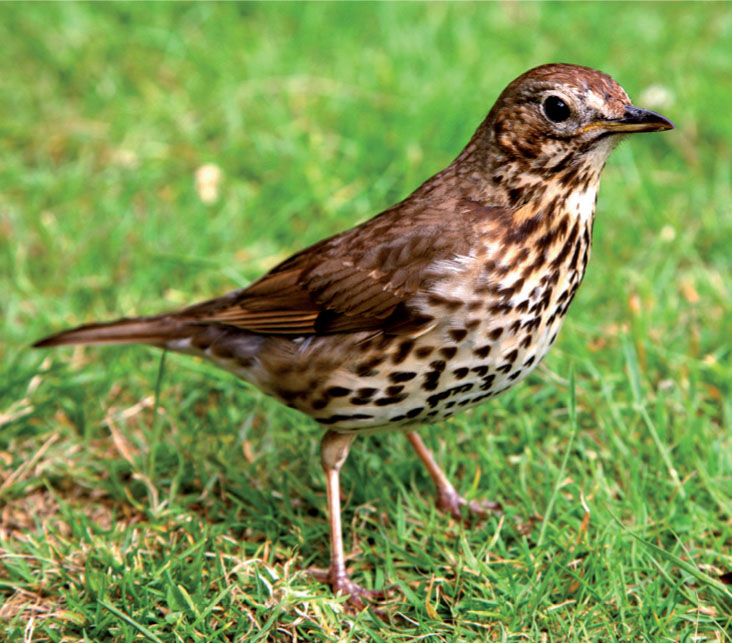
Song Thrushes tend to winter in the same areas each year, so one in your garden one year may be the same you see the next.
Redwing
Turdus iliacus
A delicate winter thrush from Scandinavia and beyond, rarely seen in gardens until freezing weather strikes.
HOME NEEDS
Distribution: A winter visitor across most of the British Isles.
Habitat: During winter, they visit grassy fields, preferably with nearby cover such as hedges and woodland edges, and they also rootle among leaf-litter. Berry-rich hedges are favoured, and they will abandon inhibitions and come into parks and gardens in harsh conditions.
Habits: Large flocks arrive by night in October and November when their thin ‘seee’ calls can be heard overhead. They rove around the countryside looking for good feeding sites, moving either when the weather changes or the food is exhausted. They usually feed on the ground, hopping and stopping across short turf, although they quickly fly into cover if disturbed.
Food: On arrival in autumn, they will gorge on berries and other fruit, in particular haws, but much of their time is spent looking for ground invertebrates such as beetles and their larvae, caterpillars, worms and snails.
Roost: In dense cover, such as evergreens, thorny thickets or dense woodland.
So… Be ready when cold weather comes to put out windfall apples on the lawn. If you have space for a Hawthorn or Rowan – or several – then there is every chance that your resident Blackbirds may leave a few berries for them.

The pale stripe over the eye and the ‘bleeding’ side separate the delightful Redwing from the similar Song Thrush.
Mistle Thrush
Turdus viscivorus
This is the thrush with a football rattle call and a song that can be heard for miles. You’ll need a big lawn and tall trees to keep this one happy!
HOME NEEDS
Distribution: Resident throughout almost all of the British Isles, although rarely in large numbers.
Habitat: They need tall trees and large expanses of open, closely cropped natural turf, so they enjoy parkland and the grounds of country homes, orchards and a few large gardens. They also require berry-bearing trees in winter.
Habits: They hop purposefully across open short turf, chest out. Usually the only gatherings are of small flocks in autumn. The male sings early in the year, even in storms (hence the country name, ‘Stormcock’), from the tops of tall trees. Pairs will guard favourite berry trees from all-comers in winter.
Food: Invertebrates through much of the year, especially beetles but also worms, slugs and flies. Favoured berries include Yew, Rowan, Ivy, Mistletoe, Purging Buckthorn and Holly.
Roost: In trees and bushes, often high up in evergreens.
Breeding: They defend a relatively small territory of 1–15ha, but feed over a large area in which other pairs may nest. The nest is built very high up on a thick tree branch, sometimes in a conifer, and is a large cup of twigs, moss and mud, lined with plenty of dry grasses. They raise two, sometimes three broods. The three to five eggs in each clutch are laid March–June and are incubated for 12–15 days. The young fledge 14–16 days after hatching.
So… Those of you with large lawns have the best chance of success, as long as they are rich in beetles. If you live anywhere near open meadows, parks or sports fields, you too can hope for a visit, so consider growing a fine Holly or Rowan on your boundary so that a pair may come to claim it.
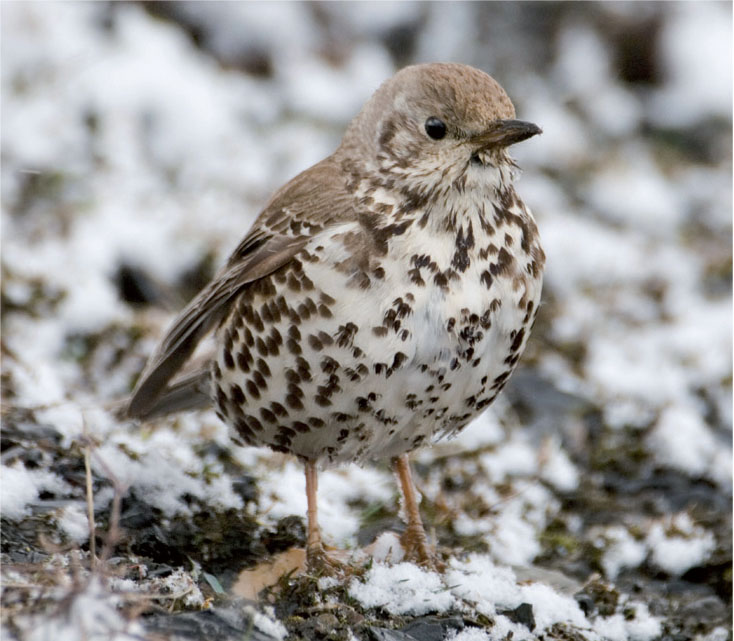
Notice how the breast spots on the Mistle Thrush are round on a white background, compared with teardrops on buff of the Song Thrush. It is unusual to see this larger cousin of the Song Thrush in small gardens.
Blackcap
Sylvia atricapilla
A warbler that comes to bird tables? It’s a strange modern phenomenon from this curiously adaptable little insect-eater.
HOME NEEDS
Distribution: Common and increasing summer visitor to much of southern Britain; scarce but increasing in Ireland and Scotland. Some birds that breed in central Europe winter in southern Britain.
Habitat: In summer, a bird of mature deciduous woodland, rare but getting more frequent in large gardens. However, wintering birds in Britain are regularly seen in suburban gardens, especially in the south and west, and migrants turn up in many coastal gardens.
Habits: In summer, they spend much of their time in the treetops, but they need a good shrubby understorey too. In winter, they still require trees and shrubs but also come onto bird tables and feeders for food. They can be very loyal to an area of gardens for several weeks.
Food: In the breeding season, they eat insects. They then switch to berries in later summer, enjoying elderberries, blackberries, currants, buckthorns, honeysuckles, Fig, Strawberry Tree, Ivy and more. They eat pollen in spring, such as Goat Willow. At bird tables, they are especially fond of fat and cut apples, but will take peanuts, cheese and coconut.
Roost: In dense cover.
Breeding: They defend a small territory, often less than 1ha. They nest low down in dense cover, often in bramble or nettle patches. They build a lovely cup of grasses, leaves and spiders’ webs, finely lined with grasses and hair. They raise one, sometimes two, broods. The four to five eggs in each clutch are laid April–June and are incubated for 10–16 days. The young fledge 8–14 days after hatching.
So… In larger gardens, encourage them to breed by creating a woodland feel, full of a thick understorey where they can nest safely. In winter, many of us will be treated to a visit if we offer a constant supply of apple halves and fat balls.
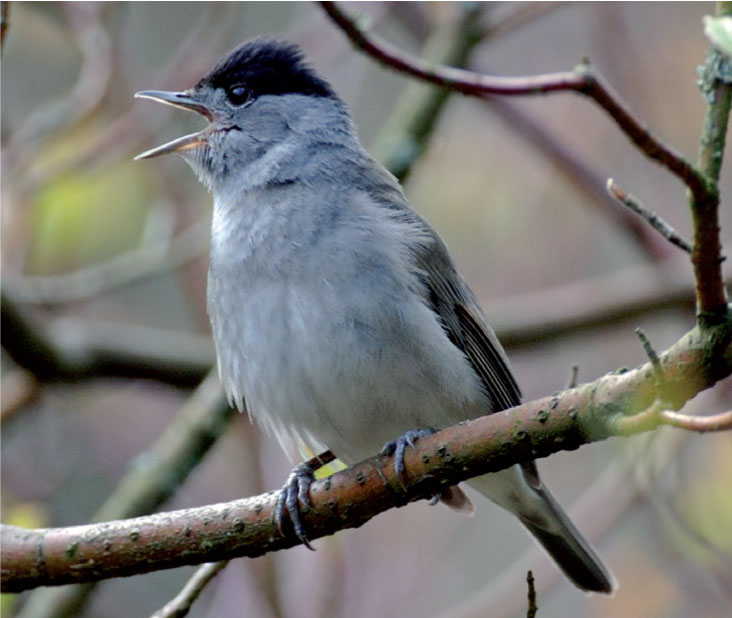
A black topknot on grey is the adult male Blackcap’s uniform; in females the crown is coppery.
Goldcrest
Regulus regulus
So small and seemingly vulnerable, you would never suspect that this fragile little bird can fly hundreds of miles over water or survive the Scottish winter.
HOME NEEDS
Distribution: Resident throughout much of the British Isles. Many more come here in winter from Scandinavia.
Habitat: In the breeding season, found mostly in mature conifers. They can survive where there are just a few, such as Yews in churchyards, but most live in plantations of spruce, Larch and fir. They are more widespread on migration when they visit mixed trees, including Sycamores, and shrubs in hedges and gardens where they often latch onto tit flocks.
Habits: They need to eat almost constantly, and so flit about restlessly, usually high in a conifer. They sometimes seem in a world of their own, oblivious to our presence. In winter, they tend to stick to fixed feeding areas. Populations crash in hard winters.
Food: Insects such as springtails, bugs and moth caterpillars, spiders, plus a few spruce and pine seeds. They are very rare at bird feeders.
Roost: In dense conifer foliage, often several birds huddled together.
Breeding: They defend a territory of around 1ha, nesting high on the ends of conifer branches and building a warm ball of moss, lichens and spider silk entered through a tiny hole. They raise two broods. The 7–12 eggs in each clutch are laid May–July and incubated for 15–17 days. The young fledge 17–22 days after hatching.
So… Large conifers are the key if you want regular visits and breeding pairs; if not, they will visit garden hedges and Sycamores on occasions.

Don’t mistake the Goldcrest, with its dark eye in a blank face, for the similar but much rarer Firecrest, a visitor to a few southern gardens in spring and autumn.
Spotted Flycatcher
Muscicapa striata
Few garden birds have declined as much as this one. If you have a chance, every bit of help for this perky tree-top bird is welcome.
HOME NEEDS
Distribution: A summer visitor from Africa throughout the British Isles, but numbers have plummeted for reasons poorly understood.
Habitat: They like big trees, usually deciduous, that offer open perches overlooking glades and sheltered airspace. They are fond of riversides, big gardens, cemeteries and parkland.
Habits: They arrive here in late spring, rarely before May. Much of the day is spent high in a tree on favourite exposed twigs (‘snags’), launching after insects and looping straight back to the perch.
Food: A specialist in catching flying insects, especially flies, beetles and aphids. They may take caterpillars when rain stops play, and in autumn will eat berries such as Elder.
Roost: Poorly known.
Breeding: A pair has a territory of around 0.5–2ha. They build their nest on a ledge or in a nook, such as in Ivy or against a house wall, with shelter above but with a panoramic view. It can be at any height from ground level up to 10m or more. The nest is a loose cup of small roots and twigs, grasses, moss, lichens and feathers. They will take to an open-fronted nest box with a very low ‘front wall’. They raise one to two broods. The three to five eggs in each clutch are laid May–July and are incubated for 10–15 days. The young fledge 10–17 days after hatching.
So… If your garden is like a sunny glade in a row of similar gardens, this could be just what a pair needs. Grow some dense climbers up your house wall, put some open-fronted boxes into gaps in the foliage, dig a pond and plant shrubberies or a meadow area to spawn insects, and keep your fingers well crossed!

The catastrophic decline in Spotted Flycatchers may in part be due to problems on migration or on their wintering grounds in Africa. All the more reason to help them here, so that as many youngsters as possible set off on the hazardous journey.
Long-tailed Tit
Aegithalos caudatus
Perhaps the most endearing of garden birds, trooping through trees and bushes in family flocks and sometimes visiting feeders.
HOME NEEDS
Distribution: Common resident in lowland areas. Distribution rather patchier in the north and uplands. Populations can crash in bad winters.
Habitat: Deciduous woods with a good shrub layer, and areas of thick scrub and hedgerows. They are infrequent in most gardens, especially in cities.
Habits: In winter, they rove in tight-knit flocks of up to a dozen around a shared territory, often following hedgelines and rarely descending to the ground. In summer, they split into breeding pairs, often aided by young male relatives.
Food: Small insects, especially bugs and the eggs and caterpillars of moths. Increasingly, they are learning to take fat, peanuts and sunflower seeds at feeders.
Roost: They form a tight huddle along a horizontal branch in a big, dense thorn bush.
Breeding: The males of a flock find a nest site within their winter territory, so there can be several pairs within a 20ha area. Some pairs choose the fork of a tree, some nest low down in thorn bushes or gorse, and some high up in the outer foliage of conifers. The nest is an astonishing hollow ‘dome’, 16cm high, of moss, cobwebs, hair and lichen, lined with hundreds of feathers. They raise one brood. The 8–12 eggs are laid April–June and are incubated for 13–18 days. The young fledge 14–18 days after hatching.
So… Put out fat balls in winter, and grow trees, hedges and thorny bushes. If they choose your garden for breeding, offer some help with their nest building needs by emptying an old feather pillow!

If it wasn’t for its tail, this would be one of our smallest birds. Having a tiny body is a real problem in cold weather, especially for something that eats little more than insects.
Coal Tit
Periparus ater
An energetic little tit showing a close attachment to conifer trees and with unusual nesting habits.
HOME NEEDS
Distribution: Found across much of the British Isles, and quite common where habitats are suitable. Most birds are sedentary.
Habitat: A bird of coniferous woodland, especially spruce, but will use most mature conifers in gardens and churchyards. It is a common bird, too, in northern and western Sessile Oak and birch woodland.
Habits: Supreme gymnasts, Coal Tits will work their way systematically along branches to feed, often at great height, dangling from cones and investigating every spray of needles. They will sometimes hover to investigate the very outer foliage. They band together in winter with other tits, and are then most likely to be seen in gardens. Occasionally in winter they feed on the ground in woods.
Food: Tiny insects and spiders, especially moth caterpillars and adults, plus bugs, small beetles, ants and flies. In autumn and winter, they take seeds of spruce, oaks, Beech, Sweet Chestnut and pines, and at the bird table eat peanut fragments and sunflower seeds. They will cache seeds and insects in gaps in tree bark, including squashing aphids together into an ‘aphid pie’.
Roost: Varied, but especially among the snug outer sprays of conifer branches, in old bird nests or in a nook in a tree trunk, but rarely inside a hole.
Breeding: They defend a territory of 2ha or more. They make their nest in a hole in the ground or among tree roots, even among rocks, and only occasionally in a tree hole or nest box. The nest is a pad of moss lined with hair. They raise one, sometimes two, broods. The 6–12 eggs in each clutch are laid April–July and are incubated for 14–18 days. The young fledge 18–20 days after hatching.
So… If you have a mature pine or spruce in your garden, you may have resident Coal Tits. If not, a good range of feeders in winter among trees and bushes will often lead to regular visits.

You can just make out the white streak down the back of the head as well as the buffy underparts that separate the Coal Tit from the larger yellow-bellied Great.
Marsh Tit
Poecile palustris
A sneezing call is what usually alerts you to a Marsh Tit. Dull-coloured but with a dapper black cap, it is very much a woodland bird that hasn’t moved into gardens in the way that Great and Blue Tits have. Its close cousin, the Willow Tit Poecile montanus, is even rarer in gardens.
HOME NEEDS
Distribution: Found in lowland England and Wales, avoiding urban and treeless areas and absent from Ireland and almost all of Scotland.
Habitat: Large areas of lowland deciduous woodland, preferably moist and with oaks and Beech.
Habits: They seek food in trees and shrubs, especially at lower levels and often on the ground, sometimes accompanying the tit flocks which pass through their territory.
Food: Insects and spiders in spring and summer, then turning to seeds, berries and nuts in winter, especially beechmast. At bird feeders, they take sunflower seeds, peanuts and hemp seeds.
Roost: Holes and nooks in trees, or sprays of conifer leaves.
Breeding: They defend a territory of about 1–5ha. They nest in a hole in a rotten tree or stump, rarely excavating it themselves, although they may enlarge it, and they occasionally use nest boxes. The nests inside are thick pads of moss, lined with hair. They raise one brood. The seven to ten eggs are laid April–May and are incubated for 13–15 days. The young fledge 17–20 days after hatching.
So… If you live very near large woods, then keep those seed feeders filled in the hope of seeing them, and do leave standing dead wood and put up a good array of nest boxes just in case it offers them extra nest site choice.

There is a risk of confusing Marsh Tits with male Blackcaps because of the tit’s cap, but its white cheeks are a giveaway, as is the black chin.
Nuthatch
Sitta europaea
A lively tree-dweller, scuttling up – and down – tree trunks, and often revealed by their excited piping calls.
HOME NEEDS
Distribution: Throughout much of England and Wales, but only as far as the Scottish borders and not in Ireland.
Habitat: Lowland woodland with lots of mature trees, especially deciduous, with dead and dying timber.
Habits: An incredibly sedentary species. They wend their way through the branches and trunks of their home ranges, winkling and hammering out food from crevices in the bark.
Food: Invertebrates such as beetles, flies, moths and caterpillars, plus tree seeds (beechmast, acorns, etc) in autumn and winter, which are cached if there is a glut. At bird tables they take seeds, peanuts and fat.
Roost: In holes in trees.
Breeding: They defend a territory of 2–5ha. They nest in holes in large trees, often many metres above the ground, or will use nest boxes. They line the nest with wood chippings and bark, and cement up the entrance with mud to the right diameter. They raise one brood. The six to eight eggs are laid April–May and are incubated for 13–18 days. The young fledge 23–24 days after hatching.
So… If you have plenty of big old trees around, keep the feeding station well stocked in winter, don’t tidy old trees if it is safe to leave them and try putting up nest boxes for them.
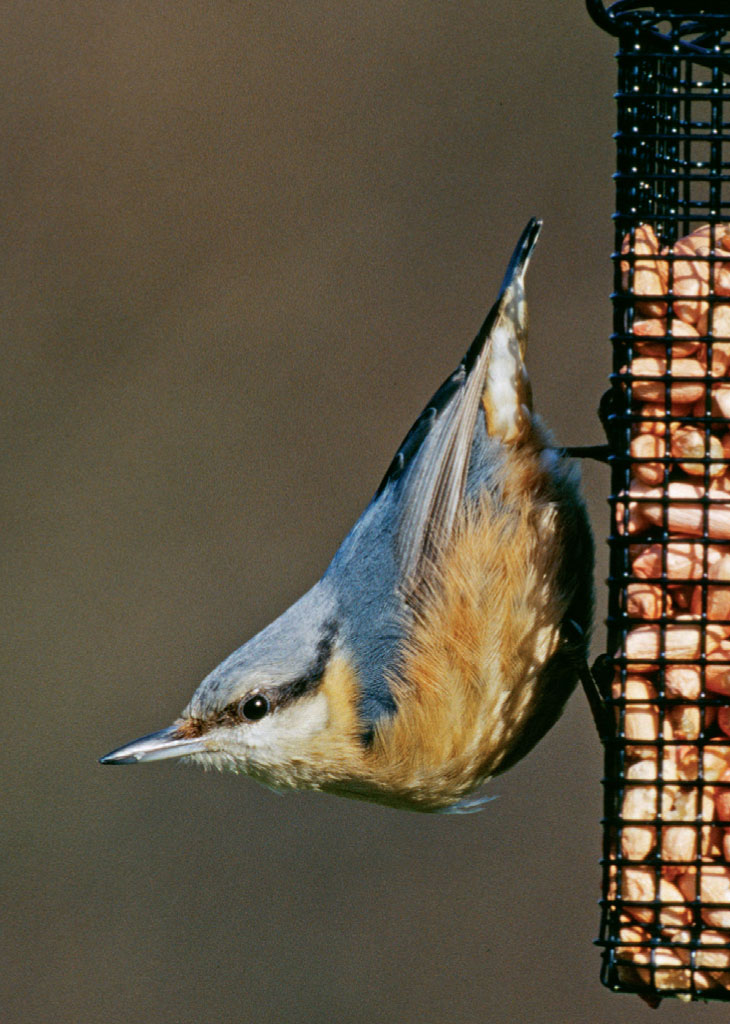
A rather compact body is what you need when most of your day is spent scurrying up and down tree trunks and noseying into every crevice around branches.
Treecreeper
Certhia familiaris
They live up to their name, expertly and endlessly shinning up mature trees.
HOME NEEDS
Distribution: A fairly common resident across almost the whole of the British Isles.
Habitat: They need lots of mature trees, visiting almost any species as long as the rough bark harbours insects, and so are mainly restricted to woodland, mature gardens and parks.
Habits: They endlessly search tree trunks and branches, often starting low and working up, even crawling beneath boughs. They sometimes travel with winter tit flocks, but hate crossing open space.
Food: Insects, especially beetles, but also flies and ants, plus spiders, caterpillars and moth eggs, and they collect aphids by squashing them together. In winter, they eat some seeds, including pine and spruce. They are very rare at bird feeders.
Roost: They snuggle into a depression in a tree trunk at about head height, sometimes communally, nibbling at a suitable site to make it a snug fit.
Breeding: They defend a territory of a few hectares. They nest behind loose bark, preferring oaks, willows, birches and elms, and will use ‘nest boxes’ that mimic this (a piece of bark strapped to a tree will do). Sometimes the nest is in Ivy or a tree hole. They drop dry wood, twigs, grass and needles into the nesting chink and line it with hair, lichens and moss. They raise one, sometimes two, broods. The five to six eggs in each clutch are laid April–June and are incubated for 12–20 days. The young fledge 13–17 days after hatching.
So… Nurture whatever large trees you have, and if you have the space for more trees, then get planting and help the Treecreepers of the future. If there are plenty of mature trees locally but few where the bark is flaking, then create artificial nest sites.
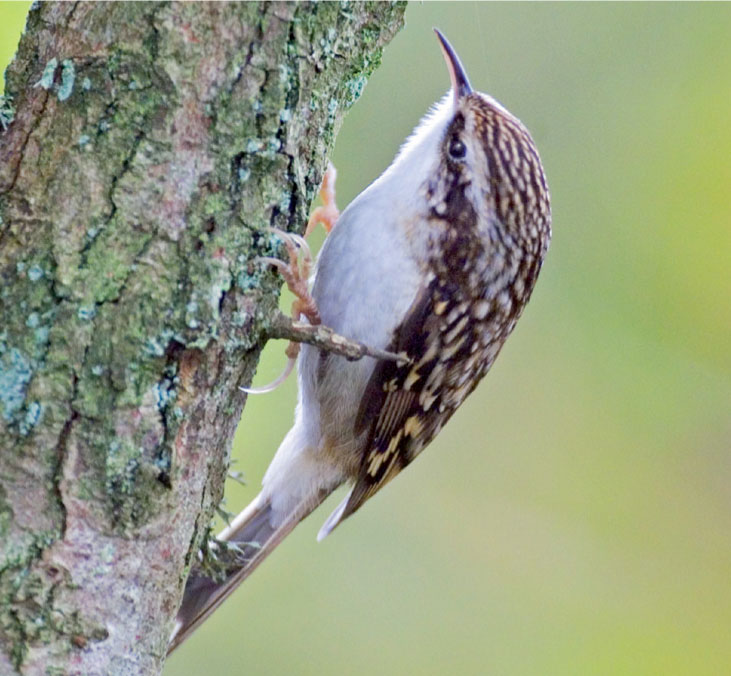
The Treecreeper is bark-patterned above and snow-white below, with the most delicate curved little beak for winkling out its insect diet.
Jay
Garrulus glandarius
The shy dandy of the crow family that goes nuts for acorns.
HOME NEEDS
Distribution: Fairly common resident throughout much of the British Isles except the very far north of Scotland.
Habitat: Naturally a bird of dense, lowland woodland, mainly deciduous, but they will use conifer forests and some have moved into urban parks and gardens. They range more widely outside the breeding season, although rarely far from trees.
Habits: A shy bird, probably due to a long history of persecution. They live alone or in pairs, usually feeding on the ground near cover, probing about in the soil and leaf-litter, and burying excess food in moss or natural depressions in the ground for recovery later. They come to bird tables occasionally, and will even dangle from peanut feeders.
Food: Beetles, caterpillars, wasps, ants, fruit, seeds, carrion and scraps. In autumn, they are incredible acorn-hoarders, seen regularly flying to and from oaks. In spring, they raid nests for eggs, nestlings, small birds and mammals. Chicks are fed on caterpillars.
Roost: In dense cover.
Breeding: They defend a territory of 5–20ha. They nest in a tree fork, on a branch, or often in a thorny bush within a wooded area, building a rough cup of twigs well lined with mosses, leaves and grasses. They raise one brood. The four to seven eggs are laid April–May and are incubated for 16–17 days. The young fledge three weeks after hatching.
So… Their tendency to take birds’ eggs and nestlings means they are not always welcome in gardens, but they are beautiful and an integral part of our natural woodland communities.
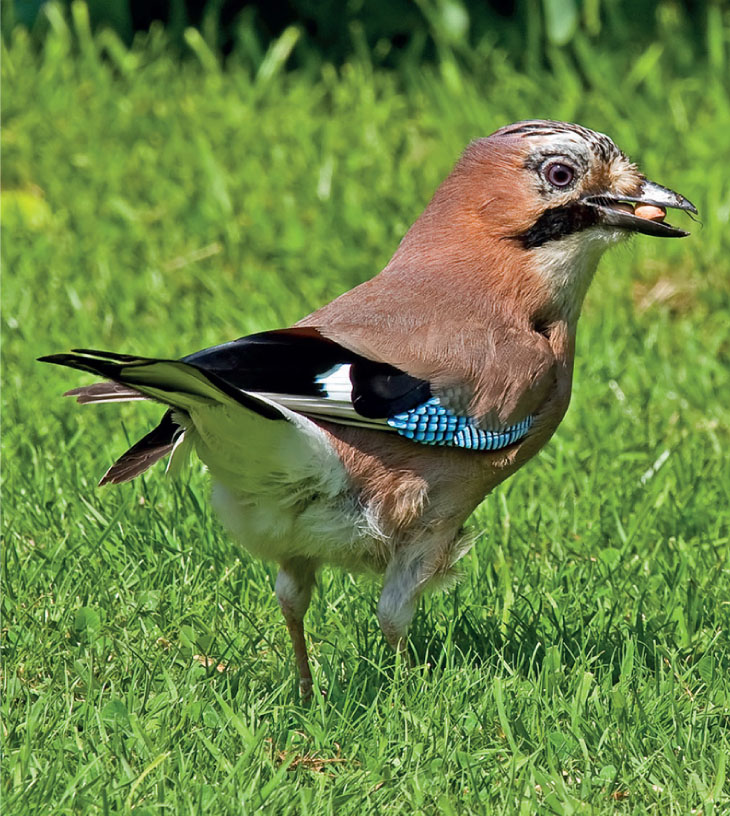
The distended throat of a butterfly-winged Jay is a sure sign that it is transporting a crop-full of nuts to a winter hiding place. On the ground it is a perky salmon-pink bird, but watch for the white rump when it flies.
Magpie
Pica pica
A striking, adaptable and irrepressible bird that would probably be a great favourite were it not for its nest-robbing reputation.
HOME NEEDS
Distribution: Widespread and fairly common in suitable habitat throughout the British Isles, except where persecution is high.
Habitat: Farmland with unimproved, short, damp grassland and scattered trees, and along hedgerows and road verges. They have recently moved into many urban areas, large gardens and parks, but avoid extensive woods, open habitats and high mountains.
Habits: A sedentary bird, often seen in singles or pairs. Most are wary and keep close to cover.
Food: Opportunistic, picking most items from the ground or by probing, scratching or turning dung. Beetles are very important, together with spiders, flies, ants, leatherjackets, caterpillars, grasshoppers, carrion, scraps, and all sorts of seeds and fruits. They help clean our highways of road kill. They take some adult birds and many nestlings and eggs, especially of open-nest species, and will come to some bird tables for scraps.
Roost: In the nest or in trees nearby during the breeding season. In winter, they often use communal roosts in trees overhanging water.
Breeding: They defend a territory of about 5ha, nesting high in a dense or thorny tree, deciduous or evergreen. The nest is a big cup of sticks, usually with a roof, and lined with mud, dung, leaves, wool and hair. They raise one brood. The five to seven eggs are laid April–May and are incubated for 21–22 days. The young fledge 24–30 days after hatching.
So… If their predatory habits bother you, don’t entice them with kitchen scraps intended for other birds and restrict your feeding to seed feeders. Importantly, give songbirds a helping hand by developing dense shrubberies and a surfeit of safe nesting sites.

What dramatic evening wear, with white dinner jacket and extravagant tails. But are Magpies evil? No! It’s meaningless to pin human moral codes on them; they are just trying to survive like every other creature.
Jackdaw
Corvus monedula
A perky and bright-eyed little crow, sociable, vocal and with a fondness for chimneys
HOME NEEDS
Distribution: Throughout the British Isles, mainly in the lowlands, but scarce in many urban areas. Many are resident, but in winter some move to lower altitudes, and some mainland British birds move to Ireland.
Habitat: They like areas of unimproved grazed pasture with groups of old trees rather than very open habitats or dense woods. Villages and country estates suit them well. They need an abundance of nest sites.
Habits: A sociable bird, mating for life and spending a lot of time interacting with other Jackdaws, either in trees or tumbling about in the sky.
Food: Omnivorous, taking grain, fruit, carrion, beetles, caterpillars, snails and more. They mostly feed on the ground, but will catch flying ants and ride the backs of sheep and donkeys looking for the insects they kick up. At bird feeders, they enjoy peanuts and can cling to hanging feeders.
Roost: In the nest in summer. In winter, they gather, often in large numbers, in traditional woodland sites.
Breeding: They form a loose colony. Each pair nests in a hole in a dead tree, wall or cliff, and they especially like chimneys and large nest boxes. They drop a pile of sticks into the hole and then make a rudimentary cup in it out of mud, dung, grasses and wool. They raise one brood. The four to six eggs are laid April–May and are incubated for 17–18 days. The young fledge about four to five weeks after hatching and are independent about five weeks after that.
So… Be aware of the risk of blocked chimneys if they nest there. They are big enough birds to dominate feeders, but apart from that they cause little problem in gardens and need little help. However, they won’t turn their noses up at a nice new Kestrel nest box, thank you!

Where there is one Jackdaw, you can usually be sure that their devoted mate is not far away, and probably several other pairs, too.
Rook
Corvus frugilegus
This is a rather fun, bare-faced, sociable cousin of the crows, whose nests dot countryside spinneys in the spring.
HOME NEEDS
Distribution: Resident across much of the lowland areas of the British Isles, bar most of northern Scotland.
Habitat: They need tall trees in copses and small woodlands for breeding, and open pasture and arable land for feeding, avoiding most urban areas, large forests and enclosed places.
Habits: They lead a busy social life in noisy, bustling breeding colonies (rookeries) of usually 20–80 pairs but they can be up to 1,000 pairs strong. The feeding ranges of neighbouring colonies overlap peaceably. They gather into large flocks in winter, and are most regular in rural gardens in harsh weather where they can be surprisingly agile at feeders for such a big bird.
Food: Beetles, worms, some caterpillars and leatherjackets, plus cereal grains, acorns and carrion. They almost always feed on the ground, winkling and probing in the soil or rooting through cowpats. They will cache excess food. They can be a problem in summer cereal crops, but equally may help reduce insect pests.
Roost: On the nest during the summer, but at other times they gather in woods with Jackdaws. Before going into roost, they perform tumbling flights known as a ‘crow’s wedding’.
Breeding: Each pair just defends its own nest, which is a wide platform of twigs containing a smaller cup of mud, leaves and twigs, lined with feathers and moss. They raise one brood. The three to six eggs are laid March–April and are incubated for 16–18 days. The young fledge 30–36 days after hatching.
So… A few large rural gardens bordered by tall trees may host a rookery. Otherwise, they will rootle around large rural lawns or drop in to scoff scraps. Few people do much to encourage them, but they rarely cause problems for gardeners.
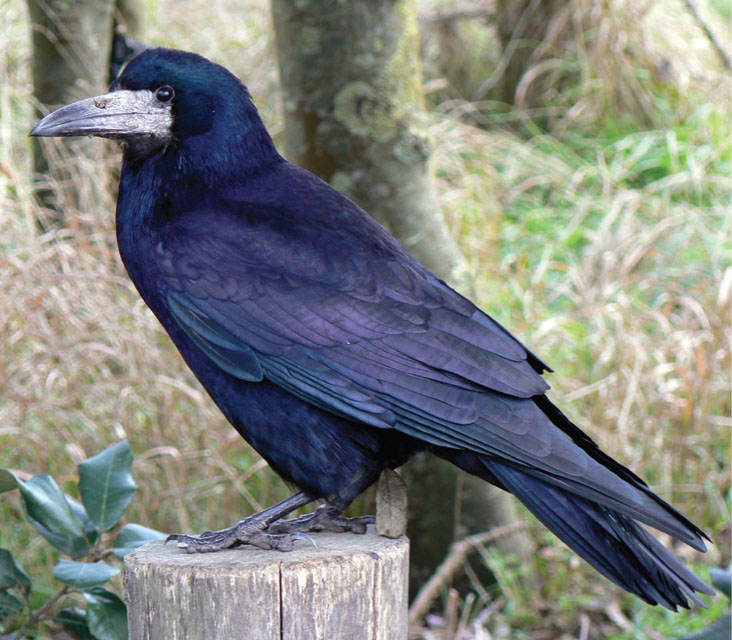
The bare white bill, purple gloss and shaggy trousers separate the Rook from the Carrion Crow, but they can be just as canny.
Carrion/Hooded Crows
Corvus corone/corvix
It can be hard to love crows. They look sinister, sound harsh and have a reputation for raiding birds’ nests. They are, of course, just doing as nature intended, but it is often best not to encourage them.
HOME NEEDS
Distribution: These two closely related species share out the British Isles between them: the Hooded is found in north and west Scotland and in Ireland, the Carrion across the rest of Britain.
Habitat: Open countryside with scattered tall trees, but also coastal areas and increasingly in cities and large gardens. In the north, they live on moorland too.
Habits: They tend to work alone or in small groups, strutting across pastures, tilled fields, stubbles, beaches, mudflats and parks, picking, probing, scavenging and investigating. Persecution has made them often wary of people, while small birds give them a wide berth.
Food: Omnivorous, taking plenty of insects such as beetles in spring and summer, plus eggs, nestlings, frogs, etc. In autumn, they will eat cereal grains. Carrion, such as road kill, is important in winter, and they will visit bird tables for scraps.
Roost: They gather in tall trees, often conifers, and sometimes on pylons.
Breeding: A pair’s territory may be 15–50ha. They nest in the top of the tallest trees, building a stick (or bone!) foundation stuffed with moss, on top of which are twigs and roots with a wool, feather and grass lining. They raise one brood. The three to six eggs are laid April–May and incubated for 18–19 days. The young fledge 28–38 days after hatching and are independent after another three to five weeks.
So… Crows intimidate smaller birds, so you might want to be careful what you put out at bird tables so as not to draw them in. If they are a problem, exclude them by only feeding things like sunflower seeds in tubular feeders.

They may be the same shape, but the all-black Carrion Crow (here) looks so different to the Hooded, which is also black but with a silvery-grey ‘tank-top’.
Tree Sparrow
Passer montanus
This is the unpredictable, shy, but ever-so-appealing, country cousin of the House Sparrow, and a species causing real conservation concern.
HOME NEEDS
Distribution: An uncommon and much declined resident in scattered lowland locations across central and eastern Britain and eastern Ireland.
Habitat: Mainly farmland where there are good mature hedgerows and copses, and often near water, sewage farms or the coast. A few come into large rural gardens but they are very rare in cities.
Habits: They are sociable all year, sometimes mixing with other sparrows and finches. Populations tend to fluctuate wildly, with colonies forming, flourishing and then disappearing just as quickly.
Food: Mainly small seeds of weeds and cereals, feeding on the ground in fields and usually close to hedgerows. At bird tables, they will take seeds but they can’t de-husk sunflower seeds. In the breeding season they seek insects such as beetles, flies, grasshoppers and caterpillars.
Roost: Apart from late summer when they use dense trees and hedges near feeding areas, they tend to roost in or near their nests.
Breeding: They form a loose colony and are highly sensitive to disturbance. They nest in holes in trees, 2–5m off the ground, and readily take to nest boxes. They stuff the hole full of stems, leaves and roots, and line the nest cup with soft material including moss, wool and hair. They raise two to three broods. The two to seven eggs in each clutch are laid April–June and are incubated for 11–14 days. The young fledge 15–20 days after hatching.
So… If you have a big rural garden in a known Tree Sparrow area, then providing nest boxes, hedges, weedy vegetable plots and plenty of supplementary seed may reap very important rewards.

It is only a lucky few who have Tree Sparrows in their garden – look for the warm chestnut crown and the black ‘love mark’ on the white cheek.
Brambling
Fringilla montifringilla
The Chaffinch’s northern cousin is an exciting if erratic winter visitor to some fortunate garden bird tables.
HOME NEEDS
Distribution: A winter visitor from northern European breeding grounds to mainly eastern Britain, they arrive in varying numbers each year depending on the beechmast crop back home.
Habitat: They visit woodlands, especially mature Beech woods, and farmland with stubbles, usually staying close to the woodland edge or mature hedgerow trees.
Habits: They migrate from northern breeding woods in autumn, arriving in the UK from the end of September onwards, with most leaving again by March. They feed mostly on the ground and usually in flocks, regularly banding up with Chaffinches in late winter. A few sometimes end up in gardens where they will visit bird tables faithfully over several weeks. If a flock arrives, they can be quarrelsome but also nervous, taking flight into trees at the first sign of danger and then filtering back down again.
Food: Seeds, with a particular taste for beechmast, but also taking grass and cereal seeds, sometimes spruce seeds, and a few berries. They are adept at digging through snow to reach seed. At bird feeders they prefer open tables and the ground underneath where they are partial to sunflower seeds.
Roost: In flocks, preferring dense conifers and undergrowth, often many kilometres from where they may have fed.
So… Bird tables are your biggest hope of seeing Bramblings. Keep them well topped up with sunflower seeds and check out those Chaffinch flocks regularly in winter.
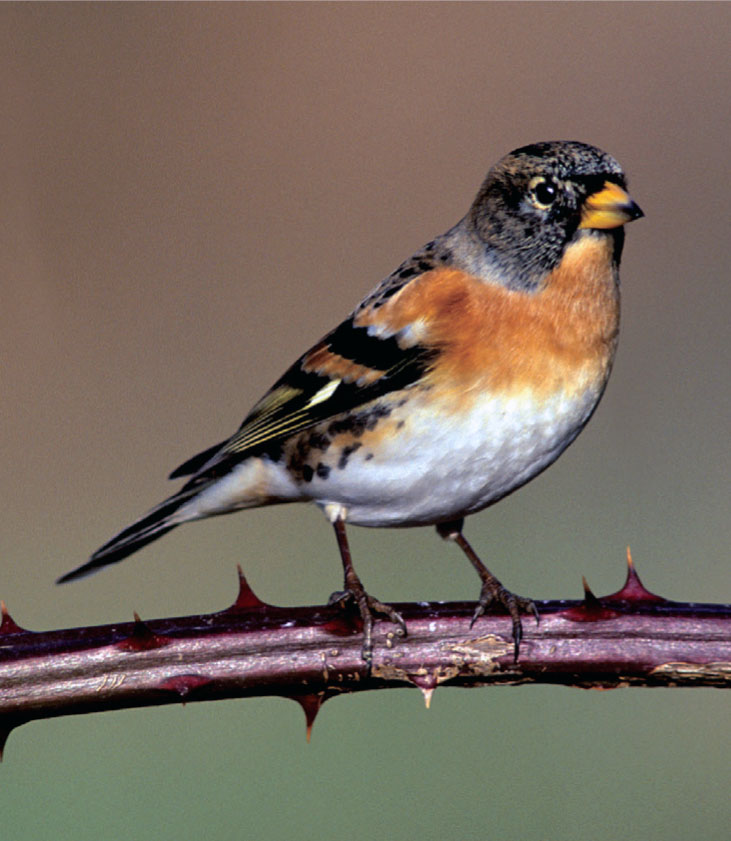
It’s quite tricky telling Bramblings and Chaffinches apart, but see how the former’s ruddy chest is sharply divided from its white belly, its wingbar and shoulder are rusty too, and there are freckles on its flanks. When it flies off, look out for its white rump.
Goldfinch
Carduelis carduelis
Who says our garden birds aren’t beautiful? This is a feisty little ray of sunshine, increasingly regular in gardens.
HOME NEEDS
Distribution: Fairly common throughout lowland areas, but only as far north as mid-Scotland. It is a partial migrant, with many British birds heading to France and Spain for the winter.
Habitat: Sheltered places, often with scattered trees, where favourite weeds grow tall and lush, such as open glades, downland, unimproved grassland, riverbanks, waste ground, thistlebeds, old allotments and large gardens. It is increasingly seen in cities.
Habits: This nomad wanders in tight-knit little flocks seeking out clumps of choice flowers that are coming into seed. Their jingling calls help others know where the food is and when it’s time to move on. They are becoming more frequent at winter bird feeders.
Food: Small seeds, mainly from the daisy family (knapweeds, dandelions, thistles, etc) and Teasels, preferably half-ripe and picked straight from the plant where they are adept at clinging to stems and seedheads. They also eat pine, Alder and birch seeds in winter, buds and flowers in spring, and some caterpillars and aphids. In gardens, they enjoy nyjer seed and sunflower hearts.
Roost: In groups in dense trees and scrub.
Breeding: Pairs nest within earshot of another couple of pairs or so, and feed together in an area of 1–50ha. They nest on the swaying outer branches of trees, hidden by a branch above, and build a dinky cup of moss, grass and spiders’ webs, lined with plush plant down. They raise two, sometimes three, broods. The four to six eggs in each clutch are laid May–August and are incubated for 9–14 days. The young fledge 13–18 days after hatching.
So… Seed feeders are your simplest way of holding their attention, but you can encourage them to breed, too, if you can offer suitable nesting trees and a good turnover of ripening wildflower seeds.
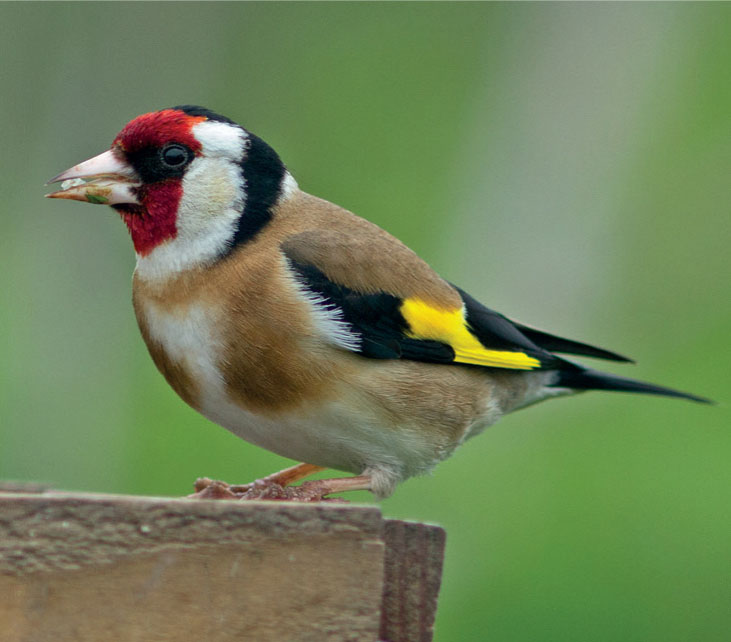
Vibrant-costumed Goldfinches are beginning to like bird feeders as much as they like Teasels, brightening up even inner city gardens. I once saw one in the garden of No. 10 Downing Street (he says, name-dropping!).
Siskin
Carduelis spinus
A vibrant, streaky little finch that has recently become a regular sight at many bird feeders in early spring.
HOME NEEDS
Distribution: In winter they extend patchily across much of the British Isles. In summer they are a much more northerly bird, although their range expanded in the 20th century and some now breed in southern conifer plantations.
Habitat: They breed in extensive mature conifer forests, so they are usually only seen in gardens in winter. Their main winter haunts are Alders, pines and birches, often near running water.
Habits: They wander in hyperactive little flocks, sometimes with Lesser Redpolls, and often dangling in the treetops. They occasionally come to ground level, often to a pool or stream edge where seeds have collected. More are visiting garden feeders these days, mainly in spring.
Food: They feed their young on ripening spruce and pine seeds, and then in late summer take seeds from herbaceous plants and a few invertebrates, before switching their attention to Alder and birch seeds for much of the winter. They eventually end up at garden feeders, where they eat peanuts, nyjer seeds, hemp, linseed and sunflower hearts.
Roost: Communally in thick vegetation or conifers.
So… If you live near big forests, your garden may be visited throughout the winter. For most of us, keeping well-stocked feeders right into spring is our best chance of success as they begin to get hungry.

In some gardens, flocks of several dozen twittering Siskins can now gather in spring to feed up before heading back to their breeding woods. This is the male with a black crown, but all have the black-and-yellow striped wings.
Lesser Redpoll
Carduelis cabaret
This acrobatic, buzzing little finch is an unusual but increasing winter visitor to garden trees and feeding stations. The ‘poll’ is the forehead, and is indeed as red as a ruby.
HOME NEEDS
Distribution: Much declined, it has a patchy distribution across the UK, although rare in southern parts in summer.
Habitat: In the breeding season, they are found in open woodlands with birch trees, plus young conifer plantations and heathy areas, but are very rare in gardens. In winter, many stay in their summer habitat but some move to riverside Alders and, increasingly, to gardens.
Habits: Gregarious, especially in winter, with jangling flocks of up to 30 dangling at the tips of fine branches.
Food: Throughout the winter, birch seeds are vital, which they extract with their very fine bill. They will also take Alder, Larch and spruce seeds. They sometimes feed on weed seeds on the ground, such as Tansy, nettle, thistles and Meadowsweet. They very occasionally come to seed feeders, especially nyjer.
Roost: In trees.
So… If you have space, plant a nice mature birch tree (or clump!). A stand of Tansy nearby, or a nettle-bed if you can face it, may give them extra options, but your best bet is to put out nyjer seed.
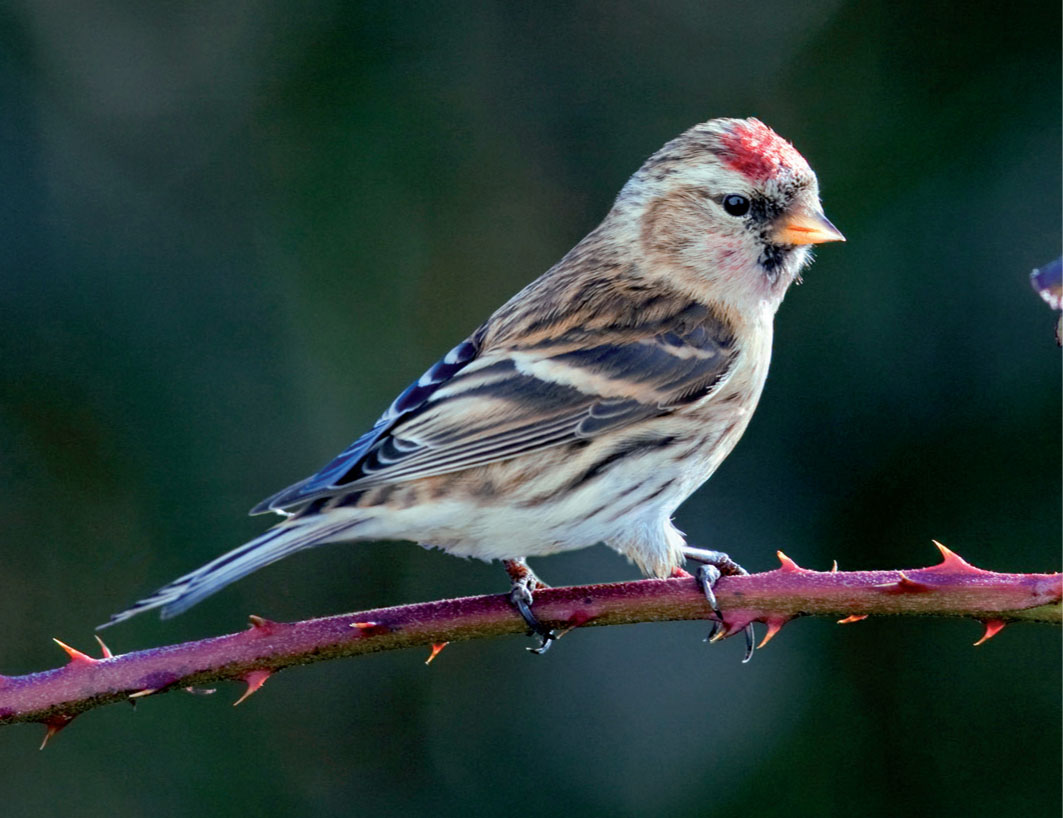
Even in winter, the Redpoll retains the feature that earned it its name – a small, red mark on its forehead. Its streaky back and sides, wide pale wingbar and its little black chin also help to identify it.
Bullfinch
Pyrrhula pyrrhula
The chubby male Bullfinch is one of the most vividly dressed birds, his mate a subtler version. This is a bird that has been struggling, so do all you can to help.
HOME NEEDS
Distribution: Sedentary throughout most lowland areas of the British Isles, though never common, and thinly scattered in the north.
Habitat: Large woodlands, whether mixed, coniferous or deciduous, with dense cover and sunny glades. They also like thickets and overgrown hedgerows. They often move into orchards in spring and, in winter, they mostly grace rural gardens.
Habits: Shy, retiring and unobtrusive, they are usually found in pairs or small groups, roving quietly through cover.
Food: Nettle seeds are an important part of the diet, so this is one occasion when nettles equals gardening for wildlife. In spring they love fruit blossom such as apples, plums and pears. In autumn and winter they take a wide range of seeds and berries including Ash keys and the seeds of goosefoots and docks. They take some invertebrates for their chicks, such as caterpillars and spiders, and occasionally come to feeders to take sunflower hearts.
Roost: Thick evergreens and conifers.
Breeding: Pairs don’t seem to defend a territory. They nest 2–3m up in thick bushes and dense trees, often in evergreens and usually away from the main trunk. They build a cup of twigs combined with a mélange of moss, rootlets, grass, lichens, hair, wool and aromatic leaves. There are two to three broods; the three to six eggs in each clutch are laid May–July and are incubated for 12–14 days. The young fledge 15–17 days after hatching.
So… If you can, grow a thick, tall, native hedge, create a woodland garden with a good shrub layer, grow fruit trees, and develop a ‘wild’ area with a nettle-bed.

The female Bullfinch looks just like this male but with almost all the colour drained out of her. If you are lucky enough for a pair to take to your feeders, they may keep returning for weeks.
Yellowhammer
Emberiza citrinella
The male’s ‘little bit of bread and no cheese’ song is a hallmark of country lanes – or was before numbers plummeted. It is a scarce winter visitor to mainly rural gardens.
HOME NEEDS
Distribution: Resident and widespread throughout much of Britain, but very rare in urban areas and the uplands, and disappearing in the north and west.
Habitat: They enjoy sunny and dry places with scattered shrubs and open ground, so are found in farmland hedgerows, downland and heathland. They visit just a few gardens in winter.
Habits: They feed on the ground in places where they can retreat quickly into cover. They gather in small flocks in winter, usually in stubble fields or where farm animals are fed.
Food: Mainly large grass seeds and cereal grains, plus weed seeds, tending to ignore oily seeds. They also eat a few insects such as beetles and caterpillars.
Roost: In reeds or in thick, low vegetation such as bramble thickets.
Breeding: Only exceptionally in gardens. In the countryside, they nest on or near the ground in thick cover or in gorse or other thick, low shrubs.
So… If you do back onto farmland, there is a chance you will draw them in if you plant a good thick hedgerow. Some rural gardeners are lucky enough to have them come to a well-stocked ground feeding station for finches and sparrows, especially on open ground near a hedge and away from the house.

A happy male Yellowhammer belting out his song. Females and winter males are duller with stripy heads, but retain the telltale chestnut rump, here hidden but best seen as birds fly away.
Reed Bunting
Emberiza schoeniclus
A sparrow-like bunting with a fondness for marshy places. Numbers have declined, so consider yourself lucky if they visit your winter bird table.
HOME NEEDS
Distribution: Resident and widely scattered in lowland areas throughout the British Isles.
Habitat: In summer found in damp habitats with tall herbaceous vegetation, especially reeds, such as riverbanks, canals, saltmarshes and gravel pits, but also young conifer plantations. In winter they wander more widely, sometimes joining other small birds such as Chaffinches on farmland, and occasionally venturing into gardens to bird tables.
Habits: They spend most of their time feeding on the ground in dense vegetation or clinging to plant stems, but in gardens they may hop around under the bird table, on it or even on feeders.
Food: Mainly seeds, especially grasses and cereals, plus some from the chickweed, goosefoot and knotgrass families. They take insects when they can, such as caterpillars, midges and flies, and also spiders.
Roost: Usually in reeds.
Breeding: Almost never in gardens.
So… If you have a lake in your garden or a river running by it, you have a chance of seeing a Reed Bunting in the breeding season. If not, concentrate on feeding the common finches and sparrows with seed in winter and keep your fingers crossed and eyes peeled.
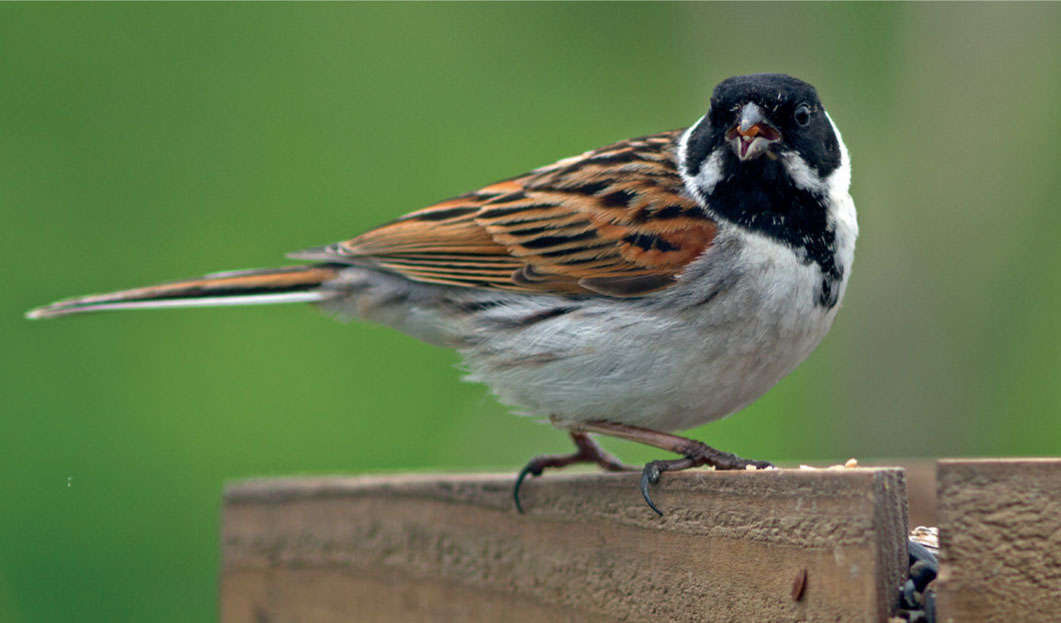
This is a dapper male in breeding plumage with his black hood and white moustache. Females and winter males have weaker head markings but retain the pale moustache.
Migrants
As well as the long-term residents in your garden bird hotel, watch out for long-distance travellers that pitch up in the small hours desperate for a room. They’re usually just after somewhere to bed down for a while, and maybe a spot of food.
Northern Europe is the flightpath for millions of these migrants. Many of them are insect-eating birds such as warblers and flycatchers that come here in summer when our countryside suits their home needs, but they then have to risk the long journey to Africa to escape our cold, insect-free winters.
They turn up in our gardens for two reasons. The first is as exhausted international arrivals. Some species migrate in giant leaps, so it is no wonder that they sometimes pitch down exhausted wherever they can after a night ‘on the road’. A garden may not be ideal but it will certainly do for an hour or so.
The other occasion we may see them is at the end of the breeding season in late summer and autumn. Young birds that have been raised here don’t just launch straight off for their wintering grounds but rove about a bit, getting their bearings and building up fat. Your garden may be a temporary stop-off in their adolescent wanderings. Some gardens are in much more favourable locations than others to receive these migrants. Anyone within a mile of the sea is well placed; anyone right on the coast is in migrant heaven.
The commonest migrants to expect are Chiffchaffs and Willow Warblers, and they often can’t resist bursting into song while they’re passing through. Whitethroats, Pied Flycatchers, Common Redstarts, Cuckoos and Turtle Doves are also all possible. You may even get birds well away from their normal habitat such as Reed Warblers in bushes instead of reeds.
HOME NEEDS
Migrants need the simple things you’d need on a short-stay after a long journey: food and somewhere to draw breath. They especially like dense cover, insect-rich habitats such as those around a pond, and anything that looks like a sunny woodland glade; in other words, many of the things that you do for other birds will benefit them too.

Fresh in from southern Europe or northern Africa in spring, many an unobtrusive Chiffchaff will drop into gardens and stock up on insects for the day.

It may be a common sight in summer farmland hedgerows, but a garden visit by a Whitethroat is a guest to savour.
Rarities
Just a handful of species account for almost all of the birds seen in gardens. For example, of almost 10,000 bird records I logged in my garden over an eight year period, 91.5 per cent were of the top ten species, and 98.3 per cent were of the top 15. And just one bird record in every thousand individuals seen was of a species not covered in this book so far. But that just proves that, very occasionally, something unusual will turn up!
If you are lucky enough to have a very large or atypical garden or one in a prime location, such as on an island or headland, or with brilliant wild habitats nearby, you can expect to beat my strike rate for rare garden birds. If you have a very big garden, you may be able to create a habitat that goes beyond what we might normally think of as a true garden habitat – a large lake, for example – in which case you could have ‘garden rarities’ daily. But for most of us, the one in a thousand may even be one in ten thousand, or, heaven forbid, one in a million.
The good thing is that those moments are incredibly memorable. You stand agog at what fate has pitched out of the sky into your tiny patch of the world. It’s like turning around on the train and finding you are sitting next to the Queen. I remember seeing a photo of a Bittern in a friend’s garden. Bitterns live exclusively in reedbeds; this one was in an apple tree! It was a very cold winter, and presumably the bird was disorientated and exhausted, and just had to find somewhere to land.
Each year, there are stories similar to this as gardens play host to some of the rarest and most unlikely birds. If it happens to you, enjoy the moment – it may not happen again for a very long time! But is there anything you can do to enhance your chances of playing host to a rarity? Well, yes. By gardening for common bird species, you will create conditions that are likely to entice a stray to stay should it pass your way.

It was an amazing day when I found one of these in my garden – a Yellow-browed Warbler. We know it must have come from deep within Russia – that’s the closest they breed.
Supplementary Feeding
Putting out a bit of food is the single sure-fire way of bringing more birds into your garden. At times it can feel a bit like cheating, it’s so easy.
To birds, it must seem like nature has created the most magical harvest. Mysterious ‘pods’ dangle from the trees, spilling an endless supply of highly nutritious seeds, while what to their eyes must look like flat-topped wooden stumps are topped with an food galore. Compared with the often-impoverished countryside, it can be a welcome feast.
Not that nature doesn’t produce its own bird-food gluts. Think of Goldfinches visiting a stand of Teasels, thrushes flocking to berry-laden trees, or Green Woodpeckers unearthing an ants’ nest. But rarely does nature produce something quite as bounteous as a bird-feeding station.
It would be nice if you could grow the seed to fill your feeders instead of having to plunder the productivity of land elsewhere, but the maths show how difficult it would be. Take sunflower seeds, for example. With good fertiliser and irrigation, farmers can get a yield of about 1,500kg of seeds per hectare. At this rate, a tennis-court-sized garden, if filled with sunflower plants, would yield about 39kg, which is less than the birds in my small garden get through in three months.
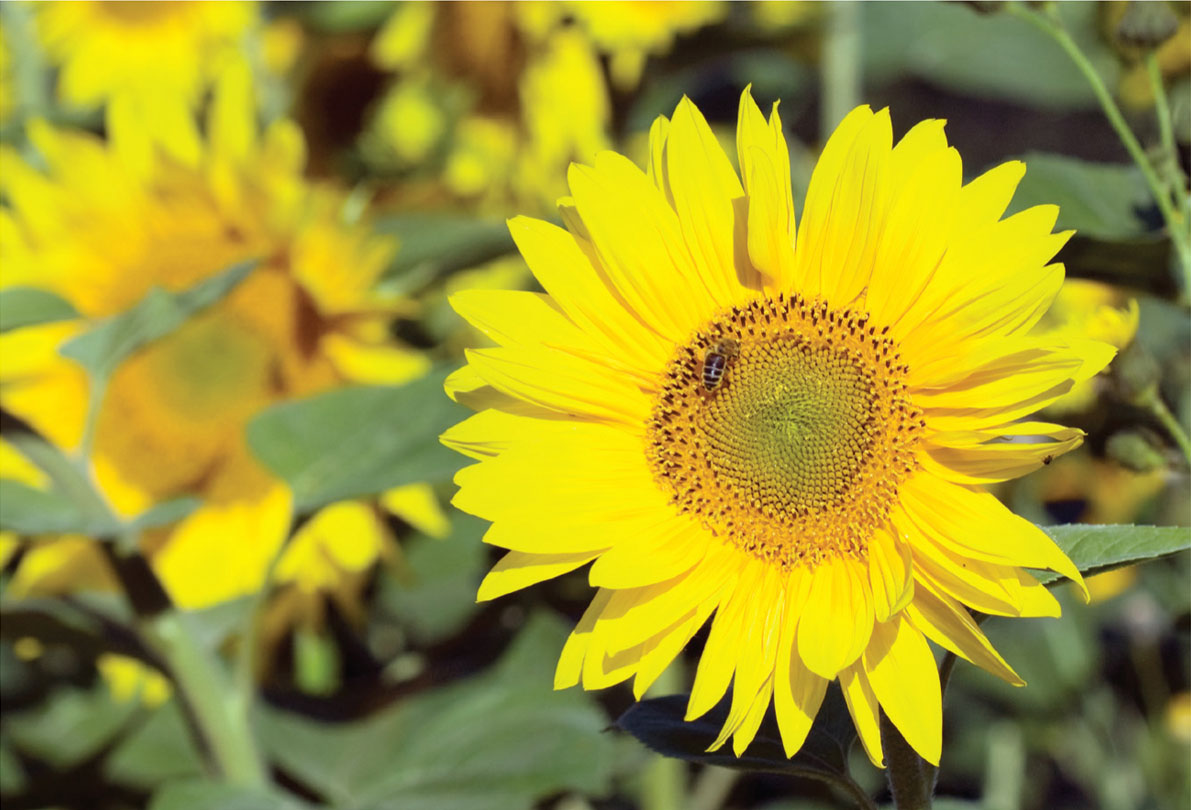
Growing sunflowers is like having mini wildlife food factories, but you can augment what you produce yourself with extra supplies grown commercially.
WHEN TO FEED
It was common practice when I was a kid to feed birds in the winter and not in summer. We now know that one of the key times in the year when many birds need it more than ever is through spring, right at the point when people often give up feeding. The RSPB’s advice is that it is fine to feed all year round, if you like.
I’m sometimes asked if there are any downsides to feeding birds. Some people worry that it makes birds lazy, so much so that if you feed regularly but then go on holiday they will starve. Don’t worry – they won’t! If birds are hungry, they will follow their stomachs. Understand, too, that what may seem like ‘your’ pair of Blue Tits or five Greenfinches is usually just a fraction of many dozens of birds doing the rounds of your neighbourhood; they all probably know many other places to find food.
Another worry some people have is whether feeding garden birds makes them easy pickings for predators. This is a complex question, because while it is true that a feeding station will often receive regular visits by Sparrowhawks or cats, by feeding the smaller birds you actually keep them fitter and healthier and hence better able to survive not only predator attack but also disease and starvation.
The key to feeding garden birds is always to do it with care. Only put out as much as the birds need, follow the hygiene rules and always view it as supplementary food, just topping up what they will naturally find for themselves. If you do all this, then on balance the benefits of feeding should far outweigh any negatives. And of course buy your bird food from the RSPB, either from reserve shops, online, or by mail order. You are guaranteed top quality products grown and produced in environmentally friendly ways, and 100 per cent of the profits goes to conservation.
Golden rules of bird feeding
 Good hygiene is essential A feeding station can attract large numbers of birds to a small area where diseases can spread. There is no point killing birds with kindness, so always follow the ‘Birds and disease’ guidelines below.
Good hygiene is essential A feeding station can attract large numbers of birds to a small area where diseases can spread. There is no point killing birds with kindness, so always follow the ‘Birds and disease’ guidelines below.
 Feeding no-nos Avoid the following: anything salted or cured; desiccated coconut; milk, and – in the breeding season – soft fat; whole peanuts, unless in a wire-mesh feeder; and bread that isn’t finely crumbled.
Feeding no-nos Avoid the following: anything salted or cured; desiccated coconut; milk, and – in the breeding season – soft fat; whole peanuts, unless in a wire-mesh feeder; and bread that isn’t finely crumbled.
 Avoid mesh bags Birds can get their feet and even tongues caught.
Avoid mesh bags Birds can get their feet and even tongues caught.
 Feed little and often Excess food can attract rats or go mouldy.
Feed little and often Excess food can attract rats or go mouldy.
 Feed somewhere quiet Back gardens are usually better than front.
Feed somewhere quiet Back gardens are usually better than front.
 Reduce the predator risk Feed high (in hanging feeders) if there are cats about. Ground feeding should be about 2m from the nearest bush – not so close to cover that cats can lie in ambush, but not so far that birds have nowhere safe to retreat to.
Reduce the predator risk Feed high (in hanging feeders) if there are cats about. Ground feeding should be about 2m from the nearest bush – not so close to cover that cats can lie in ambush, but not so far that birds have nowhere safe to retreat to.
 ‘Stepladders’ Many birds use key trees and branches to step down to feeders – watch the route they use and place your feeders at the foot of this ‘ladder’.
‘Stepladders’ Many birds use key trees and branches to step down to feeders – watch the route they use and place your feeders at the foot of this ‘ladder’.
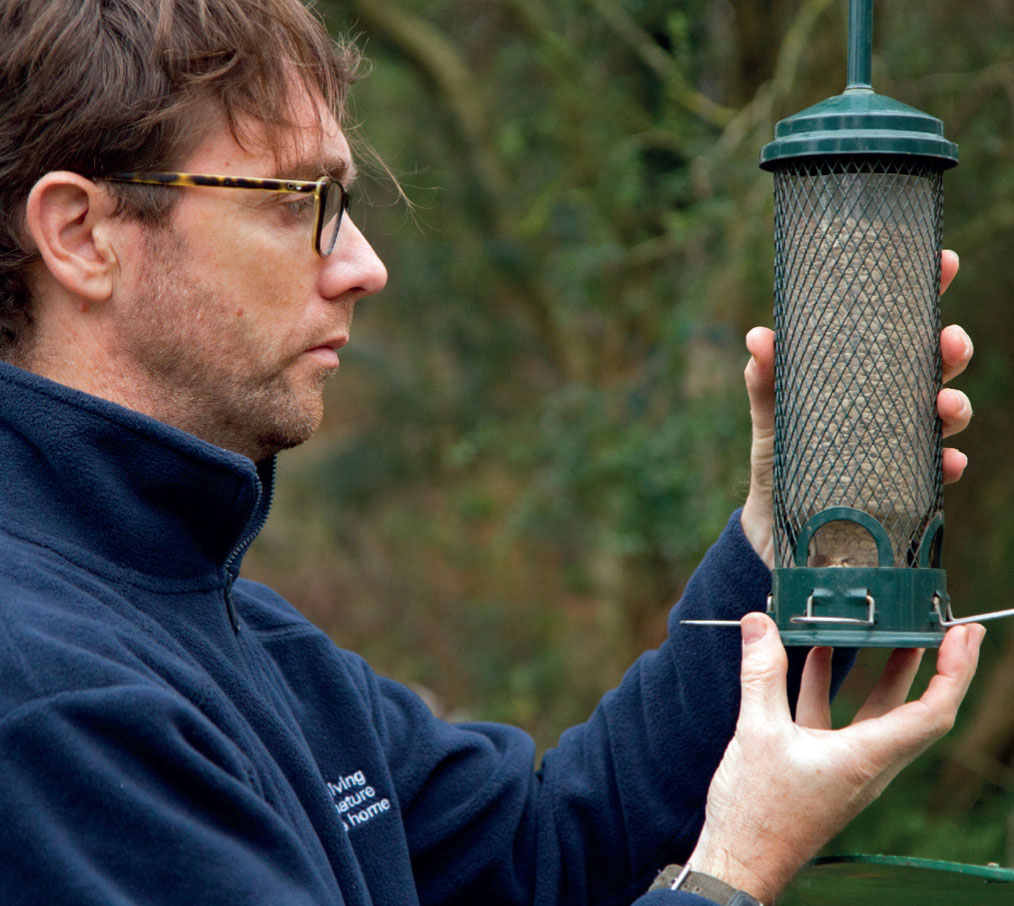
Remember your own health, and wash your hands after handling bird feeders.
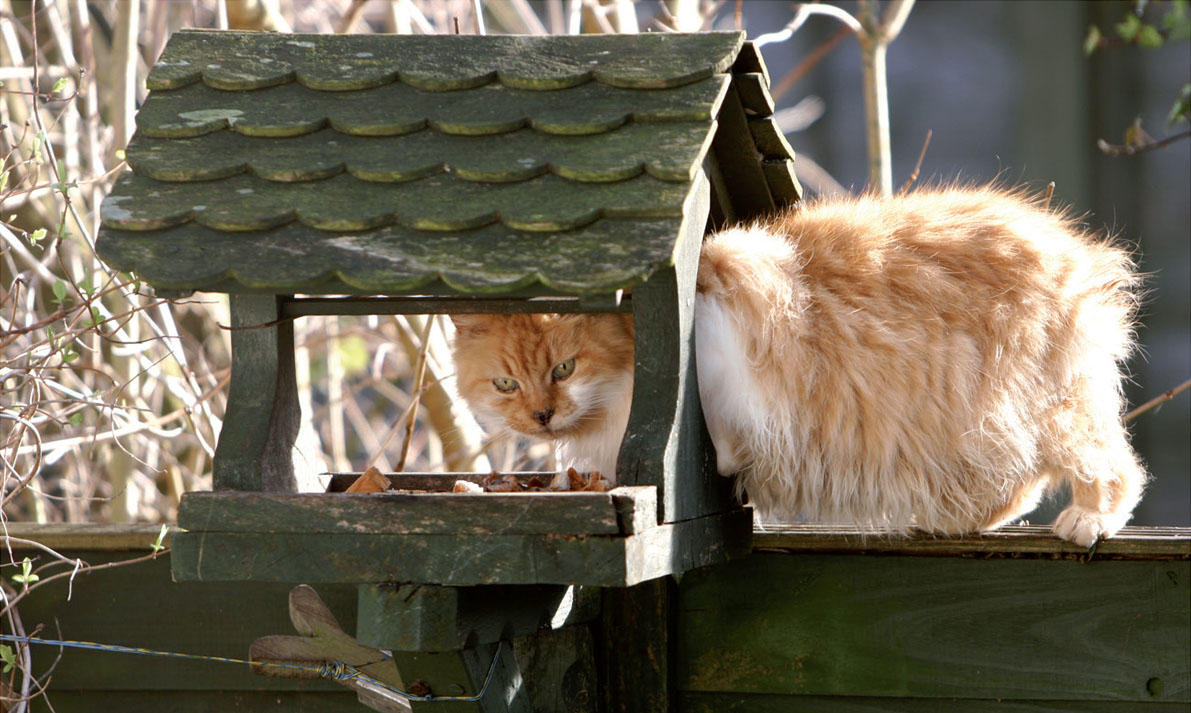
Sometimes you don’t need to be a genius to work out that your bird table is in a vulnerable position.
Birds and disease
Just like us, birds are prone to all sorts of diseases, such as salmonella, avian pox and trichomoniasis. Watch for birds that are listless and fluffed up. Minimise the risks by:
 Cleaning feeders and bird tables every fortnight using mild disinfectant and hot water. We can catch some diseases from birds, although this is very rare, so wash feeders outside rather than in the kitchen sink.
Cleaning feeders and bird tables every fortnight using mild disinfectant and hot water. We can catch some diseases from birds, although this is very rare, so wash feeders outside rather than in the kitchen sink.
 Moving the location of feeders every few weeks.
Moving the location of feeders every few weeks.
 Digging over the ground where seed has dropped.
Digging over the ground where seed has dropped.
 Removing any food that goes stale or mouldy. Never put fresh food on top of old.
Removing any food that goes stale or mouldy. Never put fresh food on top of old.
 If you see several poorly birds in your garden, take the tough but responsible decision and stop feeding for at least a fortnight to allow the birds to disperse.
If you see several poorly birds in your garden, take the tough but responsible decision and stop feeding for at least a fortnight to allow the birds to disperse.

I know, it’s a chore, but regular cleaning of feeders is far better than risking the health of the birds you are trying to help.
How to feed
Seed feeders Hung from a tree or a pole, the clear polycarbonate tubes dispense seeds through small ports and keep them dry, and the wire mesh feeders are suitable for peanuts. Special nyjer seed feeders have smaller holes. The perches mean that only small finches and tits and ambitious Starlings and Jackdaws can get at the seed. Many can be fitted with a base tray to catch spilt food, although this also offers a perch for larger birds. Some feeders have suckers to stick them to windows; interestingly, feeding very close to windows is thought to cause fewer fatalities from birds striking windows than feeders a couple of metres away.
Bird table Simple is best – go for one with a surface area of about 40 x 40cm with a cleanable, smooth surface, a low rim to stop food blowing off, and gaps in the corners to allow water to run off. Avoid tables with a nest box built in – any taker will be forced to defend it against the hordes of birds on its doorstep. Avoid tables with an integral water bowl as seed can fall in it and go mouldy. Leave the wood untreated if possible and erect it on a pole 120–180cm off the ground or hang it from a tree (but so you can still see onto it and reach it). Add a roof if you want to keep food dry but realise that it may inhibit some species from visiting, and the more elaborate the design, the more difficult they become to maintain and clean.
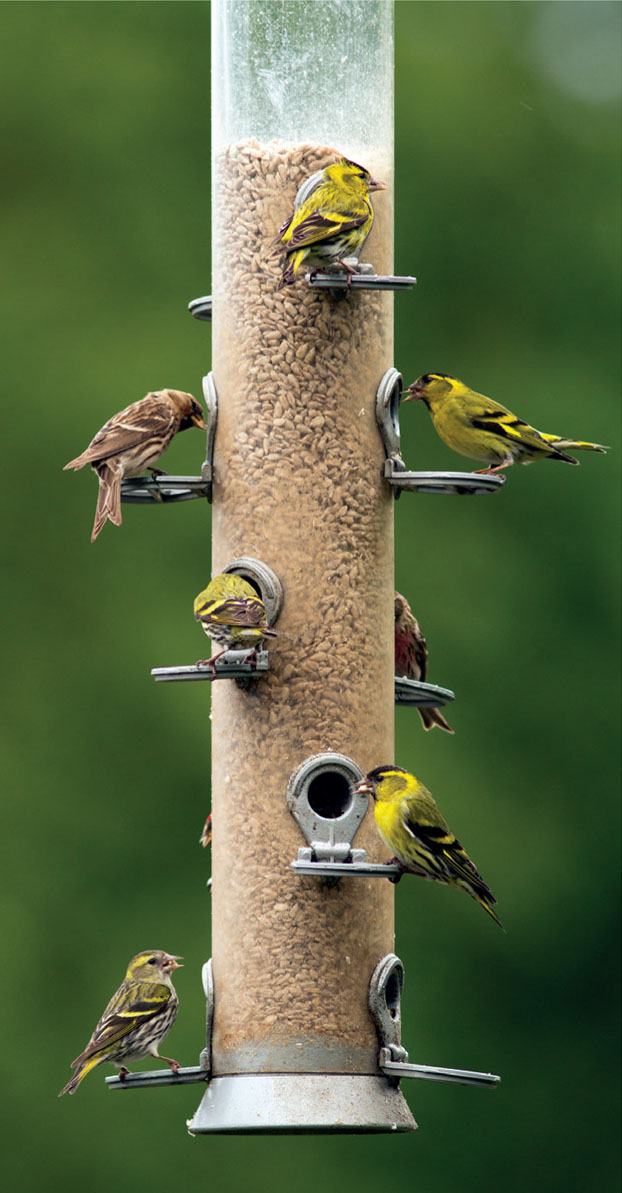
Modern polycarbonate feeders are great at keeping seed dry, and allowing you to feed the birds in raised locations where they are safer.

By having to peck off small pieces of peanut in situ, these tits aren’t at risk of choking their young on whole nuts.

Hanging bird tables are an ingenious alternative to having to dig a pole into your flowerbed, but be aware they can get blown about in the wind.
Live-food feeders Use a steep-sided dish (rather than one the mealworms can crawl out of!), preferably with a cover to keep the rain out, and place it either on a bird table or hang from a tree.
On the ground A mesh feeding table is a good idea, preferably raised about 5cm off the ground so that it can be cleaned more easily.
What to feed
Different birds eat different things, depending on what their beaks can handle and what they can digest. They have an uncanny knack of knowing what is good for them.
Although it is OK to put out various kitchen scraps, such as soaked breadcrumbs, crumbled pastry and broken biscuits, birds will do best if given proper bird food. For example, 100g of bread typically has around 200 calories, whereas 100g of sunflower seeds has more than 600.
There is a mind-boggling array of foods available, with many of them coming jumbled up in bird food ‘mixes’. So which should you go for?

feeder mix
Top bird foods
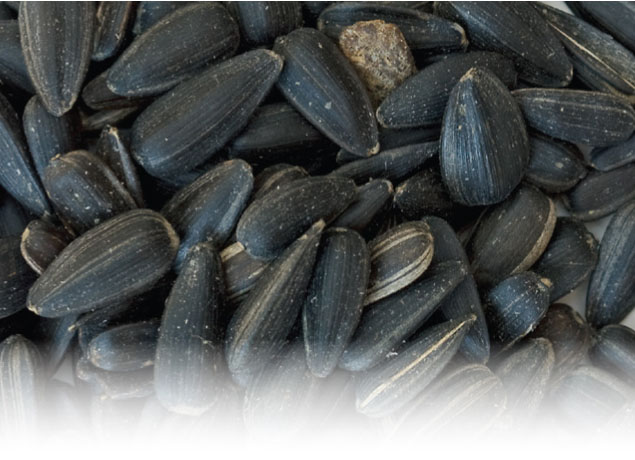
sunflower seeds
Sunflower seeds Grown mainly in southern USA, China, India and Africa, they are well liked by many birds and are rich in protein and unsaturated oils. Black sunflower seed is softer husked than striped. Birds have to nibble the husk off and discard it, so use sunflower hearts or kibbled (coarsely crushed) hearts to cut down on the mess.

peanuts
Peanuts Grown mainly in China, India, Nigeria and USA, peanuts are high in protein. Only feed whole peanuts from a wire mesh feeder (young birds can choke on large pieces), or buy peanut granules or ‘nibs’. Only buy peanuts that are certified nil-detectable for aflatoxins, a fungal poison that is lethal to birds.
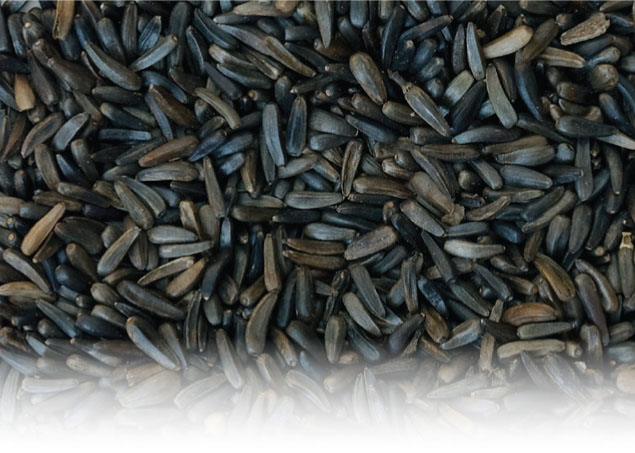
nyger seed
Nyjer (or niger) seed Guizotia abyssinica Fine seed that is usually imported from Africa or Asia. Especially liked by Goldfinches, Siskins and Redpolls.
Mealworms, the larvae of the Flour Beetle, are about 48 per cent protein and 40 per cent fat. You can buy them dead and dried, or keep them live in the fridge in sealed tubs fed with bran – either way they don’t smell! Even larger are Waxworms, the larvae of the Greater Wax Moth. Both types are excellent for Robins and thrushes that need insect protein, but only feed live or soaked mealworms in spring and summer, rather than dried, as the chicks need the moisture.
Earthworms can be bought live in pots, but why not nurture your own in the garden?
Fat Usually available as cakes and balls of animal fat (suet, sometimes rendered as tallow) but sometimes of vegetable (soya) fat. Don’t use polyunsaturated fat or butter, which can smear feathers, but grated cheese is fine. You can buy fat impregnated with seeds, berries or ‘insects’ (usually mealworms). Peanut cake, made with suet and peanut flour, is very nutritious. Only make home-made fat balls in winter, as the fat softens and goes off in warm weather (commercial fat balls are specially formulated to stay hard).
Fruit, such as raisins and sultanas, is ideal for thrushes and Robins. They are best fed on the ground unless you have pets, in which case feed from a table. Store windfall apples in autumn and put them out through the winter.
Grit/oystershell Gives female birds a source of calcium in spring to help them form eggs.
OTHER SEEDS AVAILABLE, OFTEN IN MIXES, INCLUDE:
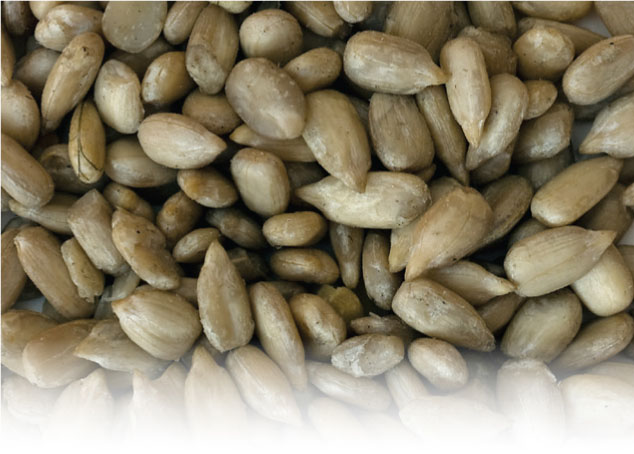
canary seed
Canary seed Small starchy seeds from an annual grass native to southern Europe but now grown mainly in Canada and Argentina.
Hemp As in cannabis. Used to be widely available as birdseed, often causing a rather dodgy crop to grow underneath the feeders!
Maize (Sweetcorn) Usually comes kibbled, cut or flaked.
Millet A number of unrelated grass species with small seeds, including Red, White, Yellow and Japanese. Enjoyed by House and Tree Sparrows, and Reed Buntings.

oats
Oats Feed as dry porridge oats or as pinhead oats (the inside of the oat grain).
Peas Sold as ‘pea chips’ or split peas.
Rapeseed from Oil-seed Rape.
Rice Cooked is more readily taken than uncooked.
Sorghum/Milo/Milo maize A heavily cropping tropical grass.
Wheat Starchy, relatively low-calorie food, enjoyed by pigeons and doves.
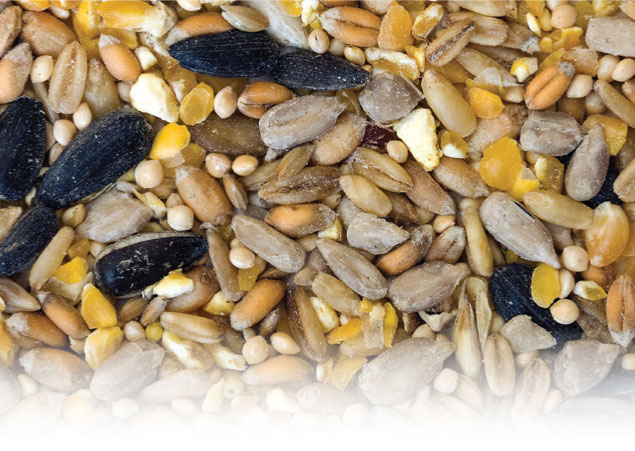
table mix
Drinking and bathing
Most birds need to drink, and most need to bathe in water to keep their feathers in good condition. The solution? A birdbath! But have you ever bought one, brought it home, and then found that nothing ever seems to visit it? There could be a very good reason for that, so here are the tricks to help guarantee a steady stream of bathing beauties to your garden boudoir.
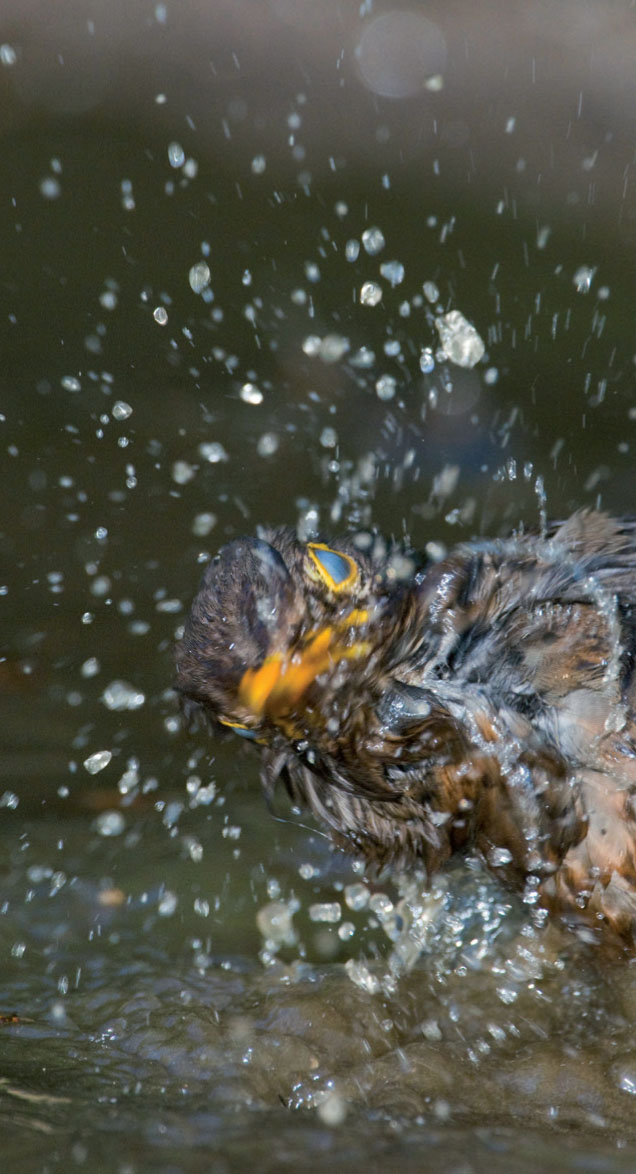
Getting its feathers wet makes a bird very vulnerable, but they have to wash sometimes. Providing water in a safe location with good visibility is therefore crucial.
The golden rules of birdbaths
The puddle rule. You can pick up birdbaths from almost any garden centre, with designs to suit all pockets and tastes, from mock Grecian to modern art. But many, far too many, are designed for what we want to look at and not for what birds want to use. Garden birds like to bathe in shallow puddles (and are scared of deep water), so think of an ideal birdbath in those terms. Choose one that has gently sloping sides and is no more than about 5cm deep in the middle. So many on the market have sides that are too steep and water depths that are too deep.
Wide is best. It will allow a whole troop of Starlings to have a wild communal bath together, spray going everywhere. Try to get a birdbath at least 30cm in diameter.
Place it carefully, not too close to cover and not too far away. Birds are especially vulnerable during and after bathing. It is fine to place it on the ground if your garden is rarely visited by cats, but if Tiddles is a regular visitor, either use a birdbath on a pedestal or even a hanging dish, although they are usually rather small.
Frozen birdbath? Never apply salt or antifreeze (don’t laugh, it has been known). The tip to float a ping pong or tennis ball in it (where the motion of the ball in the wind keeps an area unfrozen) works only in the lightest frosts. Your best solution is to tip out the ice and start again each morning with tepid water.
Quality will make life easier for you. Pick a birdbath that is easy to clean and that won’t shatter in a frost.
Tap water is fine. Birds don’t demand bottled spring water!
Keep it clean. Birds will spoil the water quite quickly. I like to give mine a quick sploosh out with the hose pipe every few days, and a good clean with dilute disinfectant followed by a thorough rinse is good practice.
And remember, often birds can get all the water they need from the food they eat, and when they can’t do that they can always get it from beads of dew or from rain, puddles, gutters or all sorts of places – after all, a sparrow’s sip isn’t very big. Many small birds will even bathe in dew.

Shallow is the rule when providing water for birds – it means birds like this Song Thrush are more likely to visit.
So if you are not visited constantly, don’t give up, for there are two times when that birdbath will repay whatever money you have spent on it:
1.During very hot weather, when there’s no dew and other water supplies have dried up, and
2.In very cold weather, when all other water is frozen.
So do invest in or make a birdbath, keep it filled and clean all year so that birds know it’s there, and when they really need it, it will be a lifesaver.
How to make a birdbath
Here is the cheapest, easiest and most successful way I have found to give birds the perfect place for a wash-and-brush up.
You’ll need:
 A galvanised dustbin lid. (Even buying the full dustbin is usually cheaper than a birdbath!).
A galvanised dustbin lid. (Even buying the full dustbin is usually cheaper than a birdbath!).
 Four bricks
Four bricks
 A small amount of gravel
A small amount of gravel
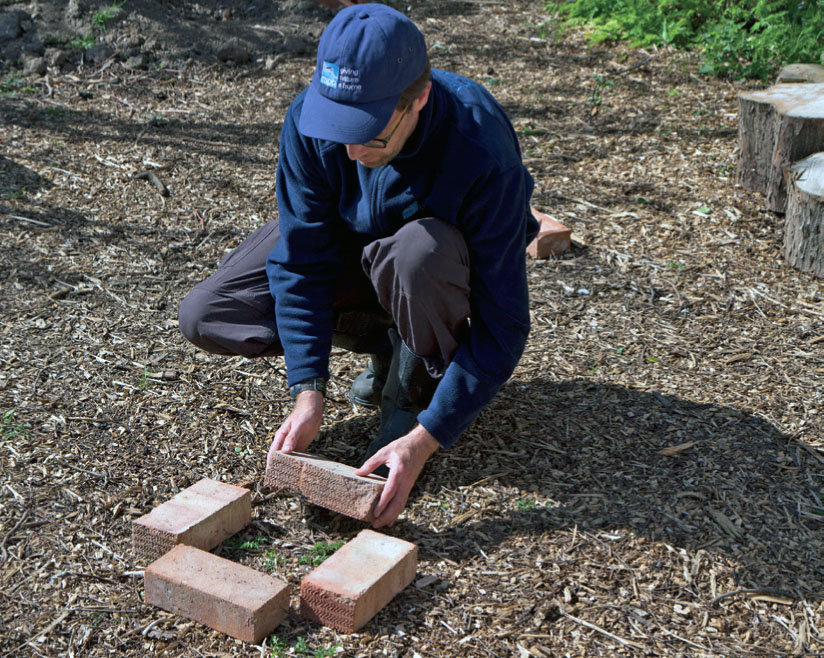
1. Place the bricks in a square, just smaller than the size of the dustbin lid.
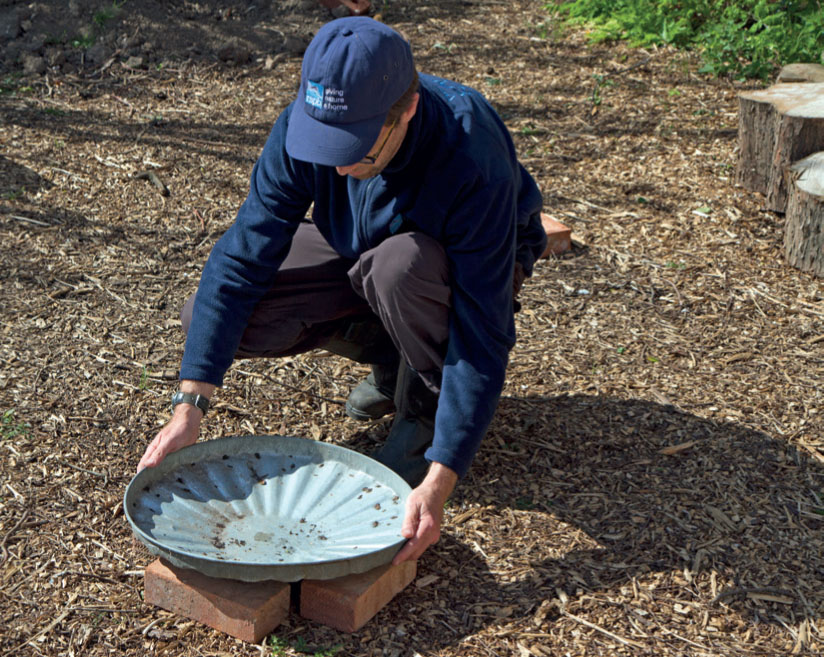
2. Turn the dustbin lid upside down on the bricks. Check it is level and steady
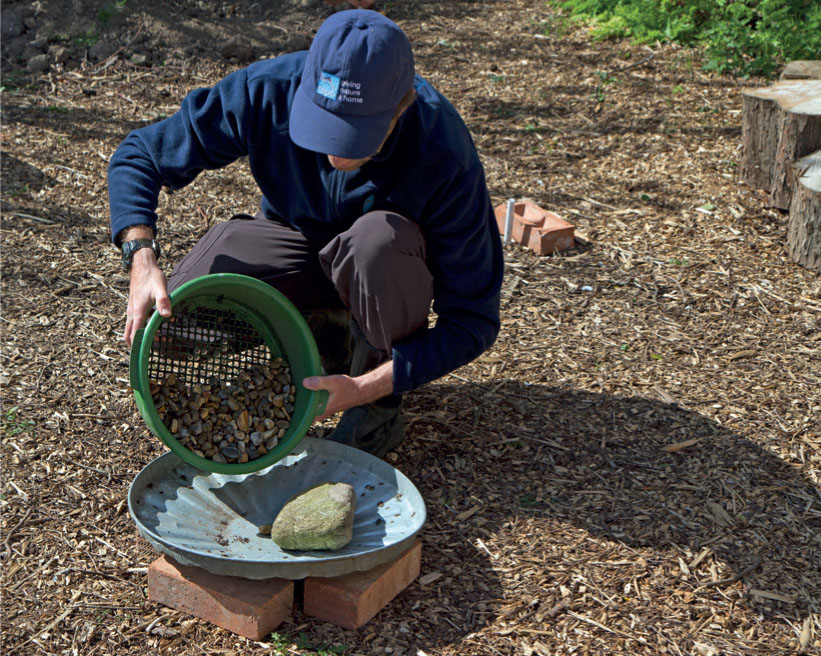
3. Place a layer of clean gravel 2-3cm deep in the lid.

4. Fill with water to the brim. The water in the middle should be no more than about 5cm deep.
It’s as simple as that!
In my dustbin-lid birdbath, I’ve had hours of entertainment as birds arrive and splash and thrash to their hearts’ content. Blackbirds, Robins, House Sparrows, tits: often several different species visit at the same time and have a whale of a time.
If cats visit the garden, it is possible to raise the birdbath up using more bricks. You can even put a ring of holly clippings on the ground around it to deter tender-toed moggies.
Dust bathing
In hot dry weather, House Sparrows, Dunnocks and Wrens will wallow about in dust, throwing clouds of it over themselves. It probably helps get rid of mites and other parasites, and soaks up excess natural oils in the feathers. Try creating your own dusty area in part of a south-facing flowerbed.
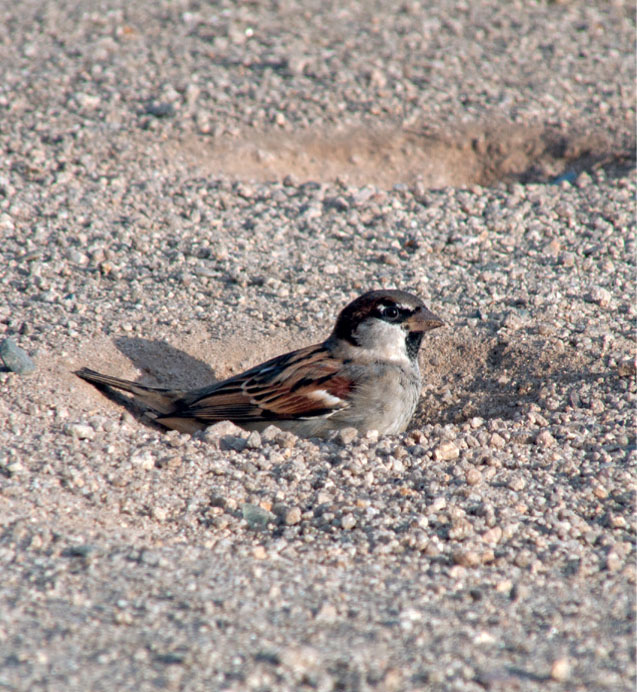
See how this House Sparrow (and his friends) have created little craters through their vigorous dust bathing.

Birds know how to spot an ‘ideal home’ when they see one.
Artificial nest sites
There’s something very rewarding about watching a Blue Tit pair shuttle backwards and forwards taking green wriggling caterpillars to an unseen but twittering brood inside a little nest box that you made (or at least erected).
Nest boxes are often necessary in a garden because the natural tree and cliff holes that they mimic just aren’t available, either because trees are too young, old trees have been removed, or modern building standards have forced us to seal up every possible hole in our roofspaces, walls and soffits.
Several people have asked me why the box they put up so lovingly has had no takers. Don’t worry, it’s probably no reflection on you – not every box gets used in its first or even second year. But it might be the wrong box in the wrong place, so hopefully this section will enable you to check that you did everything right.
But understand that, while you can feel good about putting up bird boxes, you must never then sit back thinking ‘job done’, because:
 Boxes only serve a very limited number of species. All those birds that don’t use boxes (ie most of them) need your help just as much. Check out all their home needs and you’ll see that unless you also offer all the thorny-bush, fork-of-a-tree, thick-evergreen nest sites and more, your accommodation portfolio is very limited indeed.
Boxes only serve a very limited number of species. All those birds that don’t use boxes (ie most of them) need your help just as much. Check out all their home needs and you’ll see that unless you also offer all the thorny-bush, fork-of-a-tree, thick-evergreen nest sites and more, your accommodation portfolio is very limited indeed.
 And there’s no point having somewhere to raise your young if there’s not enough food. You need to create the right habitat to go with your box. A house with an empty larder is not a home!
And there’s no point having somewhere to raise your young if there’s not enough food. You need to create the right habitat to go with your box. A house with an empty larder is not a home!
What species will use boxes?
Very regular: Blue Tit
Regular: Great Tit, Robin
Regular, but could really do with lots more
boxes please: House Sparrow, Tree Sparrow, House Martin, Starling
Would be more regular if the right boxes
were put up: Swift
Sometimes: Great Spotted Woodpecker, Wren, Spotted Flycatcher, Pied Wagtail, Nuthatch
Special big boxes only: Owls, Jackdaw, Stock Dove
If you have any species other than these using boxes in your garden, you can feel the warm smug glow of knowing you’ve got something special.
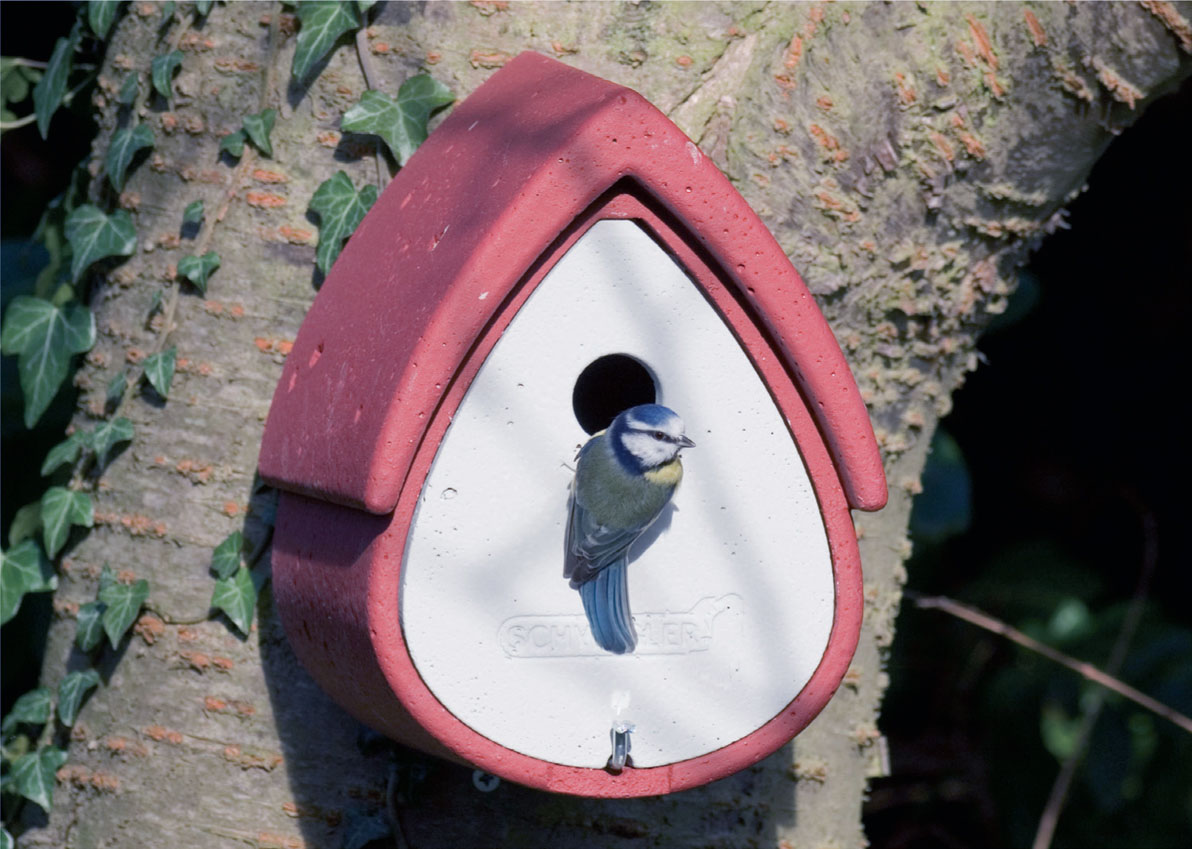
Having a pair of birds move into a home you’ve provided and raise a family is hugely rewarding, but remember this is your cue to meet their other home needs too.

Blue Tits have by far been the most willing occupants of artificial nest boxes – but there are plenty of other species to try and encourage.
The golden rules of bird boxes
CONSTRUCTION
Size matters Different species need different size boxes. Check out the size chart. Precision isn’t required but close approximations are!
Materials Select exterior wood at least 15mm thick, preferably 18mm, from a Forest Stewardship Council-certified source. Alternatively ‘woodcrete’ boxes are available, a mix of wood shavings and cement.
It’s got to be snug Ensure the joints are tight so that no rain can seep in and make sure there are drainage holes drilled in the base.
Don’t make it too jazzy! You don’t have to stick to a boring brown box, but don’t make it so obvious that predators will spot it a mile off. How about going for chic camouflage? Avoid nest boxes incorporated into bird tables, which can give the prospective homeowners a real headache trying to defend their territory.

When you see what’s going on inside a nest box, you can see why the depth of the cavity is important – if the box isn’t deep, the stretching chicks, raised up on their bed of moss, would be vulnerable to predators reaching in through the hole.

Boxes don’t have to be wood – here’s one made from a substance called woodcrete – but all the rules about dimensions, drainage and location still apply. Metal is a definite no-no for nest boxes – it would get too hot.
No chemicals please You can treat the outside of a box with a water-based preservative, but inside should be untouched, rough wood.
Birds demand security Use a metal guard around the hole to keep Great Spotted Woodpeckers and Grey Squirrels out. And no perches beneath the hole, please – that’s just an invitation to predators.
Don’t put straw in nest boxes It can harbour the spores of aspergillosis, which causes lung infections in birds. Use hay or let them fill it themselves.
LOCATION, LOCATION, LOCATION
Choose your location carefully A quiet part of the garden is ideal – next to your front door might be good for you but not for them. Above head height is usually better in gardens where cats are a problem, but some species do like to nest low down. You can put boxes near each other, but Robins and tits are territorial and only one box will be used per species in most gardens. The exceptions are House and Tree Sparrows, Starlings, Swifts, House Martins, Swallows and Jackdaws, which will nest colonially. Most birds need a clear flight path in.
A sunny aspect? No! To avoid fried chicks, most boxes should be placed facing somewhere between north and south-east.
Don’t harm trees when erecting the box Fix the box to the tree using wire threaded through rubber tubing, or at a push use galvanised screws.
When to put it up? Autumn is best, to allow birds to familiarise themselves with it, but there is no absolute rule. Just be prepared that if you put one up in spring, it may not be used until the following year.

Here I’ve tied my homemade Blue Tit box to a tree rather than hammering in nails, although I’ll still need to go back to loosen the wires as the tree grows.

Oops. How to break all the rules of a nest box: close to feeders, swaying in the wind and sun, and the wrong dimensions! Yet, amazingly, this box was used by Blue Tits, presumably because nothing better was available.
LOOKING AFTER YOUR BOX
Clean it out every couple of years, anytime from September to January, but I recommend September or October, as later in the winter birds are more likely to be using the box for roosting. Remove the nesting materials using gloves and discard any unhatched eggs (which is quite normal). Blast the inside of the box with boiling water to kill parasites. Let it dry thoroughly before putting it back up.
And don’t look in the box while it is in use! Your only safe way to see what is going on is to install a box with a little remote camera.
Spring bedding sale… As well as feeding birds, do you put out nesting materials in spring? Feathers, sheep’s wool, human hair, hay, dog and cat combings – all will be gratefully taken back to the box.
Nest box size chart
Whether making your own box or buying one, here are the all-important sizes you need to encourage different species. Brilliant small boxes are available to buy very cheaply, but if you do want to make your own, use galvanised nails or screws. For hole nest boxes, you will need a special drill bit designed for the purpose, without which making that hole is a bit tricky! All timber should be 15mm thick at least, and the box draughtproof.
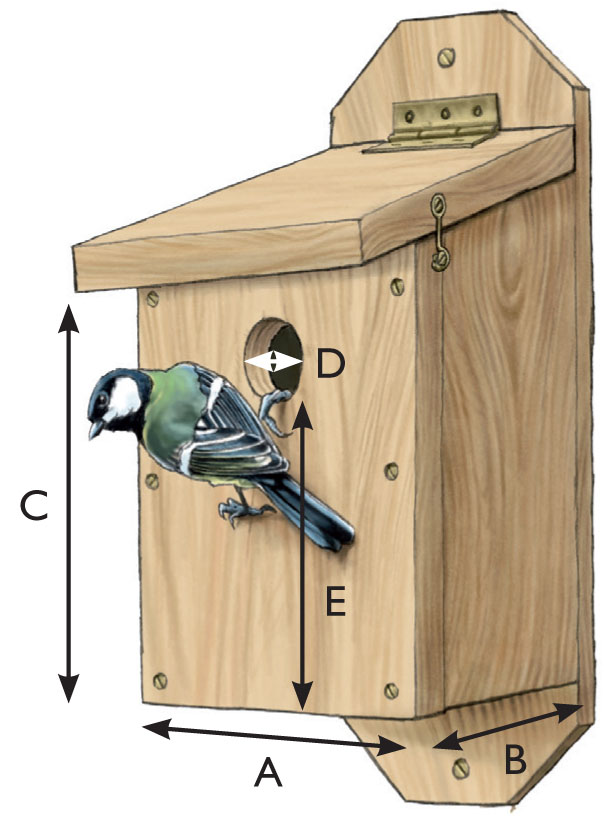
| NEST BOXES WITH ROUND HOLES | |||
| The depth from the hole down to the base of the box is crucial. I see far too many boxes for sale that are just not suitable. If the box isn’t deep enough, it is that much easier for a predator to reach in and get the nestlings, that’s if the box ever gets used in the first place. | |||
| Species | A x B x C | D | E |
| Blue Tit and Coal Tit | 15 x 15 x 20cm | 25mm | 13cm |
| Great Tit and Tree Sparrow | 15 x 15 x 20cm | 28mm | 13cm |
| House Sparrow and Nuthatch | 15 x 15 x 20cm, or a terrace of 3 boxes together. | 32mm | 13cm |
| Starling | 18 x 15 x 25cm | 45mm | 17cm |
| Jackdaw | 30 x 30 x 40cm | 150mm | 20cm |
| Great Spotted Woodpecker | 15 x 15 x 40cm Fill the box with a block of balsa wood or stuff with wood chippings. | 50mm | 28cm |
| Green Woodpecker | 18 x 18 x 45cm Fill the box with wood chippings. | 60mm | 35cm |

| NEST BOXES WITH AN OPEN FRONT | ||
| Although some bird species prefer a nest box design like this, you can imagine how vulnerable the chicks and eggs are inside. The placement of these kinds of boxes is crucial – in open view just isn’t suitable. So don’t go putting them on a bare tree trunk as you would with a tit box, but hide it well behind thick vegetation or in among creepers. | ||
| Species | A x B x C– all 15 x 12 x 20cm | F |
| Robin | Place low in thick cover. | 10cm |
| Pied Wagtail | Works best set into a wall. | 10cm |
| Wren | Place low in thick cover. | 15cm |
| Spotted Flycatcher | Place with good shelter above but good visibility. | 6cm |
Unusual boxes
All of these are proven to work, but all will require tall ladders, a head for heights and, in the case of the larger boxes, considerable strength to hoick them to their required position.

Swift
By far the best option is a specially-made hollow brick that can be inserted into the shell of your building. Alternatively, and more easily, fix wooden (or woodcrete) boxes under the eaves, but they are much less frequently used.
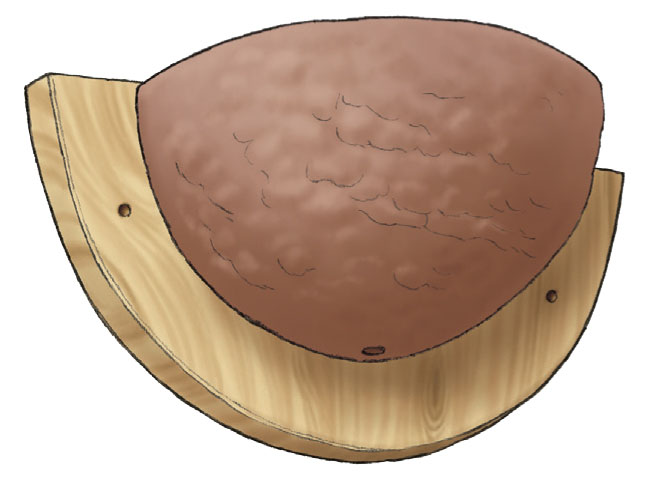
Swallow
A moulded shallow cup for a beam in an open outhouse or barn.
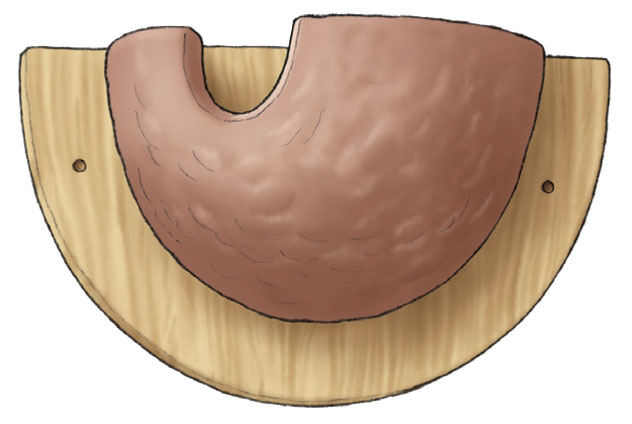
House Martin
A moulded deep cup on a backing board with a half-circle entrance, 60mm wide and 25mm deep. Place under the eaves (so that the top of the cup is tightly closed) with a clear flightpath in, and not aligned over a doorway, path or window because of their droppings.
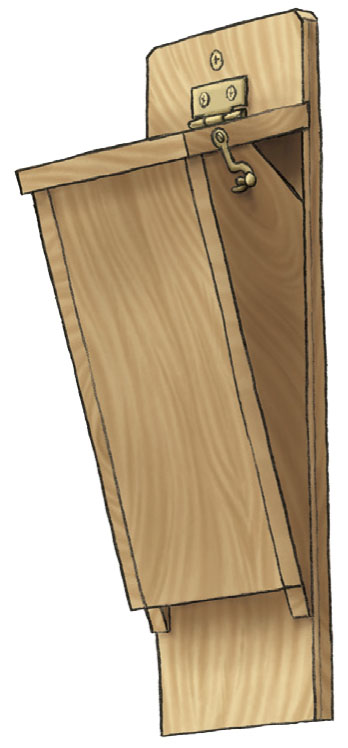
Treecreeper
A slim wedge-shaped box with a 25mm radius ‘quarter circle’ in the top back corner. Front of box 15 x 20cm, and 10cm deep at the top. Alternatively, strap a piece of bark to a tree.

Kestrel
A box (usually wooden, but moulded version shown), about 30cm wide x 30cm high x 50cm deep with overhanging canopy, half-open front and a broom-pole perch jutting in front. Site either in a tree or even on a tall pole.

Barn Owl
Usually a large wooden box, 45cm wide x 45cm high x 60cm deep, with a 23cm x 23cm hole and a ‘patio’ area. The inside has a dark ‘back room’, without which the adults feel too vulnerable. Shown is an alternative, with entrance at the top. Place in an undisturbed outbuilding up on a beam or in a tree.